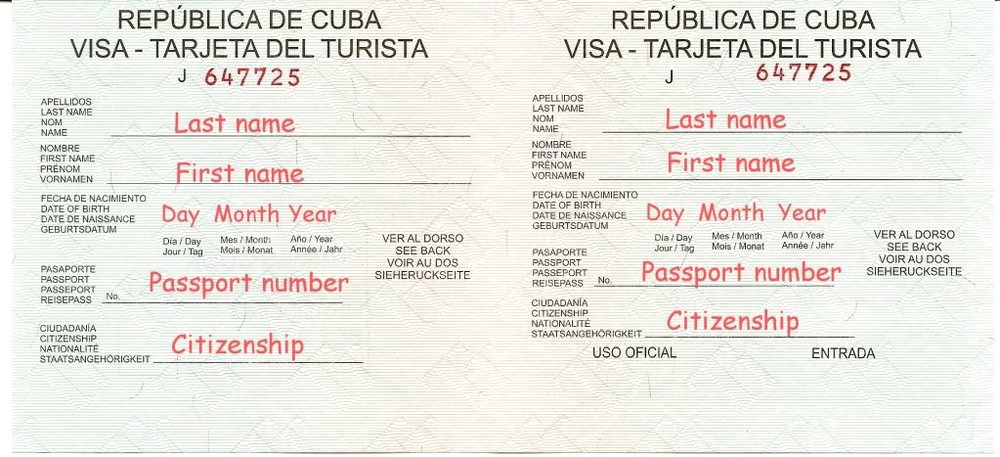
by Kelly | Apr 3, 2018 | Caribbean, Cuba, Travel, Travel Advice
(N.B. this post only addresses requirements for the “Support the Cuban People” visa, which is one of twelve visas available for Americans traveling to Cuba. While part of this post addresses legal requirements, nothing written here should be construed as legal advice.)
In 1960, the U.S. Treasury Department’s Office of Foreign Asset Controls (“OFAC”) placed an economic embargo on the country of Cuba. For practical purposes, this means Americans cannot travel to Cuba for tourism, and cannot spend money at any institution that is owned by the Cuban government or military. If you want to visit Cuba as an ordinary person (i.e. not on a volunteer/mission trip, not on an educational trip, and without close family on the island to visit), you must travel either with a group tour on the People-to-People visa, or plan your own trip with the Support the Cuban People visa. If you do not mind active vacations, the easiest option is to go on the Support the Cuban People visa.
Pre-Travel Requirements and Recommendations
Booking flights and accommodations
Flights
You can easily book a commercial flight to Havana from any major U.S. city, just like you would book a flight to any other foreign city. Five commercial carriers (American, JetBlue, Southwest, United, and Delta) offer direct flights to Havana from nine American cities (Miami, Fort Lauderdale, Orlando, Tampa, Houston, Charlotte, Atlanta, Newark, and NYC-JFK). If you are not departing from one of these airports you’ll have to book a connecting flight through one of them.
When booking your flight, you’ll be asked which visa you are traveling with. Select “Support for the Cuban People.” To enter Cuba, Americans are required to have temporary Cuban health insurance, since American health insurance won’t be available in Cuba. Most, if not all, commercial airlines include this in the price of your plane ticket. Check the enumerated fees and taxes when you purchase your ticket to ensure that the insurance is included. When in the country, your boarding pass to Cuba will be your first item of proof of health insurance if you need to use it.
Your airline will also offer you the opportunity to purchase your Cuban visa separately. The visa should cost between $85 and $100 per person depending on the airline. Also depending on the airline, you can purchase the visa online ahead of time, or at the airport from which your flight to Havana leaves: for example, if you are flying from Boston to Miami to Havana, you will need to purchase your visa in Miami, not Boston, if you are buying it at the airport.
Accommodations

AirBNB Room
To fulfill the Support for the Cuban People visa requirement, you must stay in a casa particular, which is like a bed and breakfast where the hosts live in the house in which you are staying, or select an AirBNB apartment. This is so that your money is going to a private individual, and so that you have hosts to interact with during your stay to learn more about the country from them. If no one in your party speaks fluent Spanish, make sure to book an accommodation where at least one host speaks some English. Also try to find a place that has a WiFi connection available, even if you have to pay for it. Public internet was only introduced to Cuba in 2011, and it is very difficult to come by when you are out and about. Most accommodations also do not yet have WiFi. Your host may charge you $1 or $2 per hour to use the WiFi, but at least you’ll know where and when it will be available.
Vaccines
The recommended CDC vaccines for Cuba are Hepatitis A and Typhoid. Typhoid is available as both an injection (lasting 2-3 years) and a live oral vaccine (lasting 5 years). The Hepatitis A vaccine is only offered as an injection (lasting 1 year for the first shot, 20 years with the booster shot, which may be taken after your trip). Note that you must receive the vaccines weeks before you will be exposed to the disease, so plan to receive these at least one month before traveling to Cuba if you choose to get them.
A word on the typhoid oral vaccine: while it seems beneficial to get a vaccine that will last 5 years, and to not have to get a shot, the oral vaccine is live and comes with very precise instructions. It consists of 4 pills that must be taken exactly 48 hours apart from each other. They also must be kept refrigerated at all times (in other words, don’t pick up the vaccine and then run errands before going home), not left in your mouth for more than a few seconds, and taken with very cold water to wash them down. It is also possible you will get sick and feel like you have a mild case of typhoid the day after taking each pill. This feeling may be progressively worse with each pill, leaving you feeling very sick the day after the last pill. After eight days you will probably feel totally fine and be vaccinated for years, but these side effects should be taken into account before opting for the oral vaccine.
As for Hepatitis A, you may think you are very careful with what you eat and drink, but there is really no way of knowing where or when you may be exposed to the disease. Hepatitis A is transmitted through the ingestion of fecal matter, which could happen if someone preparing food doesn’t wash their hands after using the bathroom. Considering the lack of soap and running water in the country outside of major cities (and sometimes in major cities) this probably happens often. While it is always a good idea to avoid raw food and ice while traveling in developing countries, it is also a good idea to be vaccinated against Hepatitis A in case you accidentally or intentionally let your guard down to try some of the local cuisine. I know multiple people who are careful, experienced travelers who were exposed to Hepatitis A in Cuba: those who were vaccinated had a wonderful, disease-free trip, while those who were not contracted the disease and had to live with it for weeks upon their return. Just something to consider.
Money
American credit, debit, and ATM cards will not work in Cuba because of the economic embargo. You will need to bring any money you may need with you in cash. In light of this, anything you can pay for by credit card online ahead of time should be done so (this includes your accommodations and probably some activities). After that, plan on bringing about $150 per day per person in cash. While this may seem excessive, it is better to have too much money and re-deposit it when you return to the U.S. than run out of money and not be able to pay for a taxi back to the airport.
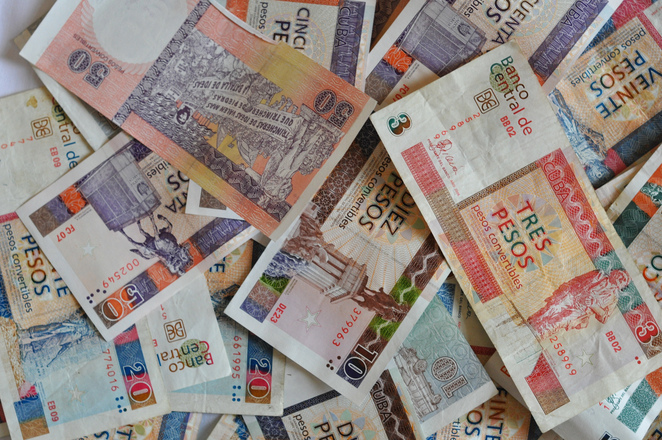
There is mixed advice out there on whether it is necessary to convert USD to CAD or EUR before traveling to Cuba. Cuban money exchanges (“Cadecas”) will take USD, but a 10% fee is charged to convert money from USD to the Cuban CUCs because USD is otherwise useless on the island. The exchange rate is 1:1 for USD to CUC. Assuming the exchange rate of USD/CUC to EUR is 1.25:1, you have the following scenario: if you bring $1250 USD to Cuba, you will receive back 1,087.50 CUC (1,250 CUC minus the 10% USD transaction fee of 125 CUC, minus the standard 3% exchange fee of 37.5 CUC). If you first change your USD to EUR before leaving the U.S., you will exchange $1250 USD for 970 EUR (1000 EUR for the exchange rate minus the 3% transaction fee of 30 EUR), and then exchange 970 EUR for 1162 CUC (1198 CUC for the exchange rate minus the 3% transaction fee of 36 CUC). You see that by first exchanging your money to EUR you receive 75 CUC more for your $1250 USD, even with the double transaction fee.
When you are leaving Cuba, because the Cubans want to get rid of their USD, there is no 10% transaction fee, so you can just exchange all your CUCs back to USD minus the 3% transaction fee again. You may also run into airport workers such as janitors or security guards who are willing to convert your CUC to USD without the transaction fee. Usually these transactions are legitimate, though under the table from the government, but if you end up with a counterfeit bill you will have no recourse to reclaim your money.
Visa Requirement: Itinerary
To meet the requirements for the Support the Cuban People visa, you must maintain a “full-time schedule” of activities that “(i) enhance contact with the Cuban people, support civil society in Cuba, or promote the Cuban people’s independence from Cuban authorities; and (ii) result in meaningful interaction with individuals in Cuba.” Guidance on this requirement states that just staying in a private home, eating at private restaurants (paladares), and buying local goods from private vendors who approach you while you’re lying on the beach is insufficient; however, anything that involves actively engaging with locals that goes beyond this appears to be sufficient.
Full-time schedule is not defined in the law, so those looking to interpret this requirement have considered what it means to be a full-time laborer and a full-time student, and it is generally agreed that six hours per day constitutes a full-time schedule based on this analysis. You must participate in activities beyond residing in a private home and eating at private restaurants, but time spent interacting with locals at these places will count towards some of your six hours per day.
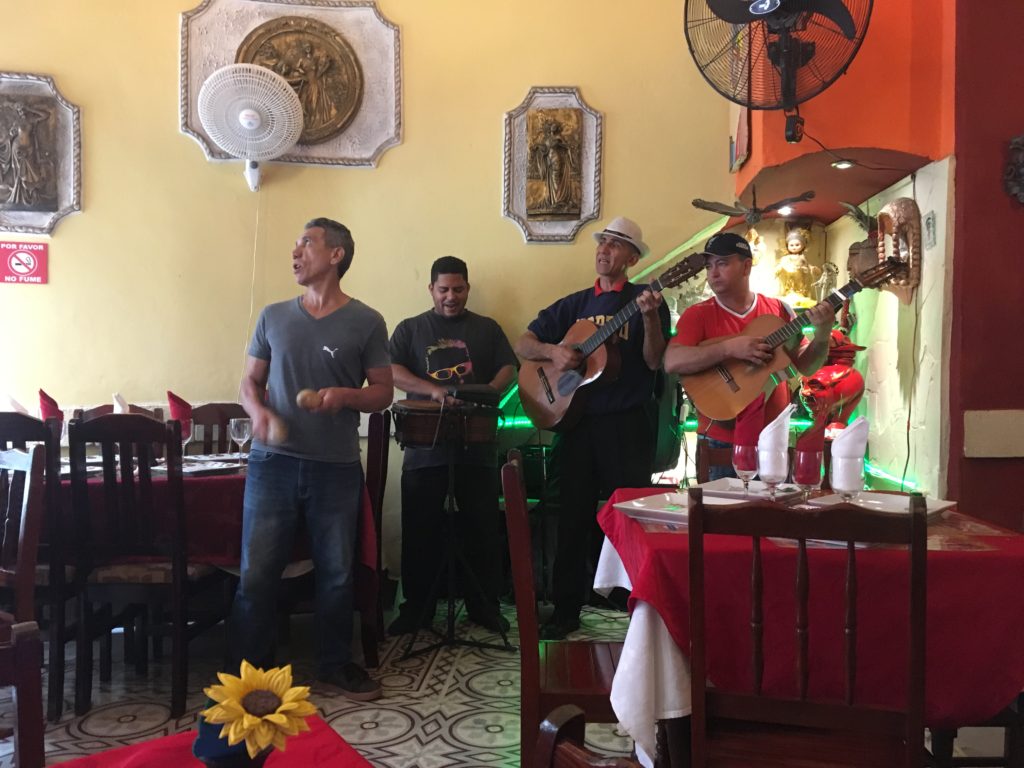
Musicians at a paladar restaurant, which clearly is also someone’s home.
It is recommended you set a full itinerary for yourself before traveling to ensure that you will meet the requirements. Visiting local museums and galleries, such as the Revolution Museum, Museum of Beautiful Arts, the Almacenes San Jose market, and Fusterlandia will count towards your itinerary, as well speaking with a local who gives you a tour of the city in his hot pink 1956 Chevrolet convertible. You may also book tours and activities via AirBNB experiences: anything listed here should count towards your full-time schedule as well. A day-trip away from Havana to see how Cubans live outside the city is highly recommended, as is a half-day bike tour around Havana. If you book tours online ahead of time you will not have to worry about spending your precious cash to pay for them in the country.
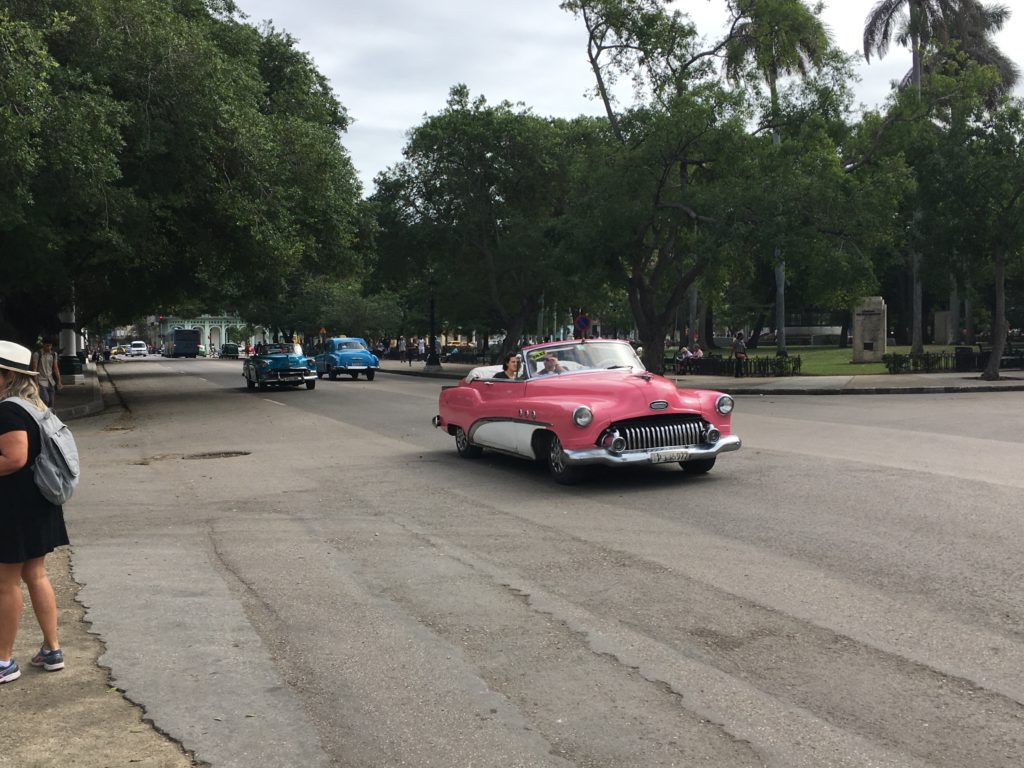
Tours in Old Cars
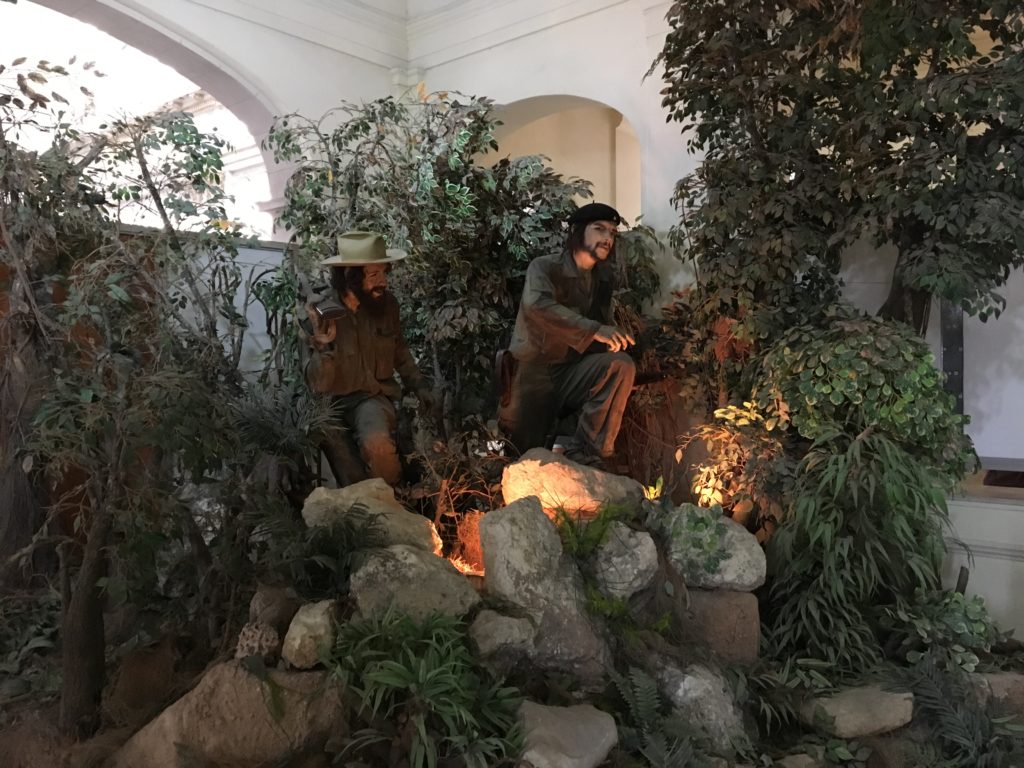
Visiting the Revolutionary Museum
You should research paladares to include in your itinerary before heading to Cuba, and try to make reservations at least for dinner for all of them ahead of time. Top recommendations include La Guarida, Locos por Cuba, El Del Frente, and La Cocina de Lilliam. For a nominal fee ($1 to $2), most reservations can be set up ahead of time using the website A La Mesa, the Cuban version of Open Table.
Arrival in Cuba
Money (again, it’s that important)
I cannot emphasize enough how you should just exchange all your foreign currency at the airport as soon as you arrive. The exchange rate will be exactly the same anywhere in Cuba, but doing this at the airport is quick and convenient, and you won’t have to interrupt your vacation for it again if you run out of CUCs later on. In one terminal there are ATM-looking machines that will complete the transaction for you. While there is mixed advice in this area, and in theory there are CADECA money exchange banks available in downtown Havana, the line to get into the bank can sometimes be over an hour long, and banks are often open at inconvenient times. The people in line and bank tellers will also only speak Spanish, so if you only speak English this transaction will be much more difficult than at the airport. You also need your passport with you to exchange money at the bank, and this is something you do not normally carry around with you in Cuba. Save yourself the time taken out of your vacation and just exchange all your foreign currency to CUCs at the airport (I certainly wish I had).
Getting Downtown
There are many normal yellow taxis waiting outside each terminal at Havana’s airport to bring people downtown. The price to get anywhere in Havana should be 25-30 CUCs. It is a set price: do not let yourself be talked into paying more unless you are considerably out of the way. To give you an idea, the ride to the intersection of San Lazaro and Calle Galiano from the airport was 25 CUC. Remember how much it cost to get downtown from the airport and don’t pay any more than that to return at the end of your trip either. This is a good rule of thumb for any taxi ride in Havana: if you only paid 15 CUC to travel from the Almacenes San Jose market to the Hotel Nacional, don’t then pay 20 CUC to return half the distance to your accommodation. Remember, you only have access to the cash you brought with you, so you are not being selfish by protecting it, you’re being smart!
Around Havana
Transportation
The easiest way to get around Havana is walking or by taxi, depending on how far you’re going. Taxis are plentiful around most tourist parts of the city and hotels, but be sure to negotiate or at least ask the price to a destination before accepting a ride! Most casa particular and AirBNB hosts will help you negotiate the price from your accommodation, since they know how much rides should cost.

Riding in the backseat of an old car
If you are brave enough to try local transportation, you may want to hop in a Taxi Colectivo! These cost about $1/person. They run set routes along major roads but will stop anywhere along the route to pick you up or let you off, just verify the general direction you’re heading before you get in. To flag a Taxi Colectivo down, stand on a main road and wave your finger up and down about waist height. These taxis seem to be safe, but be warned you may encounter some unique individuals riding in them….
Other available forms of transportation include rickshaws powered by bicycles and Coco Taxis, which are yellow, open-air motorized pieces of metal run by what appears to be a moped. There are no seat belts, they move rather slowly, and there is no protection from the elements if it starts to rain, but these can be a cheap way to get around short distances.
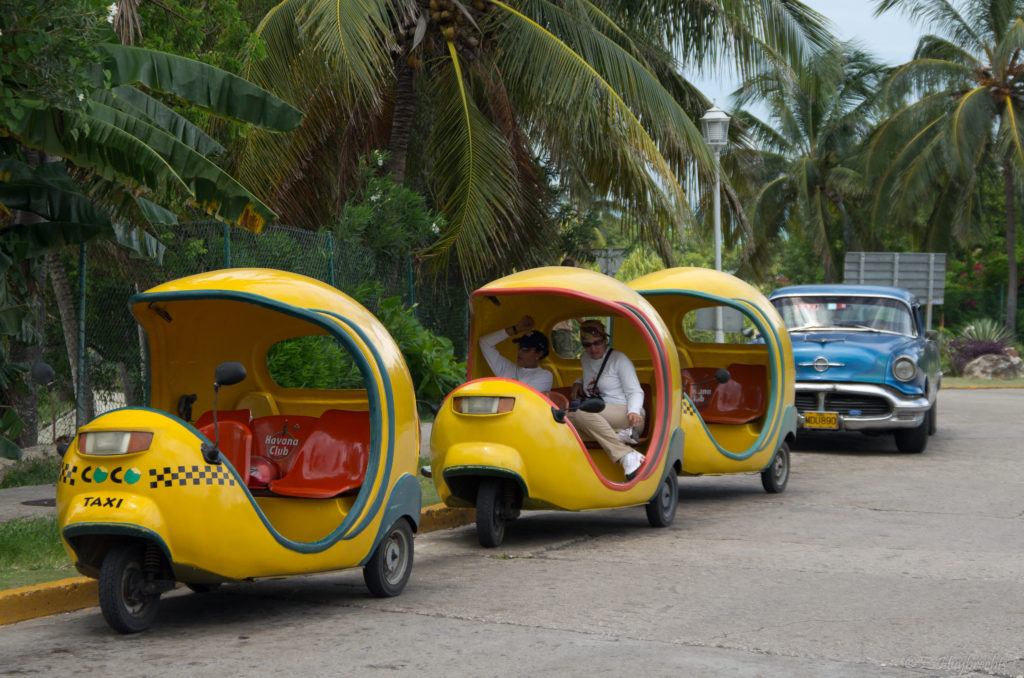
Coco Taxis
Regardless of how you intend to travel, you should download the maps.me app to your smartphone as well as the map of Cuba within the app before you leave the U.S. This app is minutely detailed and operates without WiFi. Even if your phone is on airplane mode it can locate you using satellites and provide walking or driving directions to any other location on your map. It is one of the most useful travel apps not just for Cuba but for any foreign destination.
Making Purchases
A requirement of the U.S. government regardless of which visa you travel to Cuba on is that you are forbidden from spending money at institutions that are government- or military-owned. A full list of these places can be found here. Aside from these entities, you can spend your money wherever you’d like!
If you intend to purchase cigars or alcohol, know that prices of these goods are controlled, so you will not find a better deal by shopping around. The easiest way to purchase cigars, alcohol, and coffee is at the airport right before you leave. There are shops available outside security if you’d like to place these items in your checked luggage (as would be required with bottles of liquid larger than 100 ml). Otherwise, feel free to and please do purchase souvenirs such as jewelry, paintings, and humidors from local vendors throughout the country as another way to support the Cuban people during your visit.
Safety
So long as you take precautions you would in any big city, Havana is totally safe. Because Castro’s government gave everyone a house when he came into power there are no homeless people. There are also strict laws against harassing foreigners as Cuba would like to build its tourism industry. Nevertheless, while I felt safe walking around even dark roads at night, I still wore a cross-body bag and kept my hand on my purse at all times, though this may have been unnecessary: I did not see or hear about any instances of theft or pick-pocketing. Generally if the Cubans are going to try and get money from you, they will do so openly.
A story of caution: on my first day in Havana, my dad and I arrived at the airport around 8am, and went through immigration, the health check (turning in a form that says you’re healthy) and customs without paying too much attention to the people we interacted with. Later that day walking down a very busy main tourist road in Havana, we were approached by a local who “just wanted to practice his English” and welcome us to his city. He asked where we were from and when we arrived. He also mentioned that if we wanted to buy cigars there was a huge monthly festival a few blocks away that was selling them for half-price from the factory workers. He then insisted he didn’t want anything and bid us good day.
A few minutes later as we were standing outside a restaurant contemplating lunch, a woman who spoke almost perfect English came up to us and said “the Americans! I saw you this morning, I’m an immigration officer! How are you liking Cuba so far?” At the time, my dad and I both thought the other person recognized her from the airport: in hindsight, she was clearly working with the guy up the road, who had gathered enough information for her to approach us. This interaction was followed up by the woman also mentioning the cigar festival and offering to take us there. Not realizing the two were working together at the time, the festival now seemed legitimate, as two separate locals knew about it. There was no festival: instead we were led down a somewhat deserted side street and into an apartment building where the exit was locked behind us. At that point, I gave us a 50/50 chance of being either robbed or killed. We were offered boxes of what I’m sure were fake cigars at “half price,” and were only allowed to leave when I insisted I had been asked to buy Romeo y Julietas by a friend (which was true), and these people did not have that type of cigar. After leaving the apartment, the woman insisted on showing us to a “fantastic” restaurant for lunch, and then requested $10 for her and her poor baby. We ended up giving her $5 and said that we couldn’t afford any more at the time since we were limited to the cash we brought with us and weren’t sure how much we would need, which was true.
In the end, we learned a $5 lesson when it could have been a $300+ lesson, and also got to include this encounter in our journals as an hour of”interacting with locals learning about the cigar industry.”
Returning to the U.S.
You will enter the U.S. and go through immigration and customs at the airport at which you land when you first return from Cuba. My experience going through immigration and customs was no different than returning from any other trip abroad. When asked what my purpose was for going to Cuba, I promptly said “to support the Cuban people” instead of “tourism,” and the officer smirked and let me go with no other questions. I’ve heard stories of Americans returning who have been asked by an immigration officer to produce their daily journal of activities (the itinerary or a bullet list should count), photos of all their receipts, and photos of the entire trip to prove the itinerary was followed, so you should be ready to produce those if necessary. You also must maintain all of these things for five years after you return in case you are audited by the Department of the Treasury. Note that even if you are not a U.S. Resident and you are just passing through the United States on a connecting flight back to your country, you will still need to meet one of the 12 U.S.-approved reasons for traveling to Cuba and possibly produce the proof listed above to a customs officer.
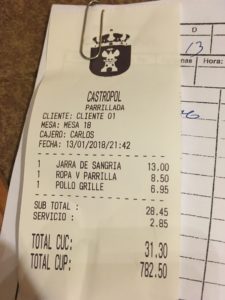
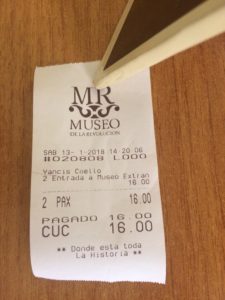
Photos of receipts for potential audits
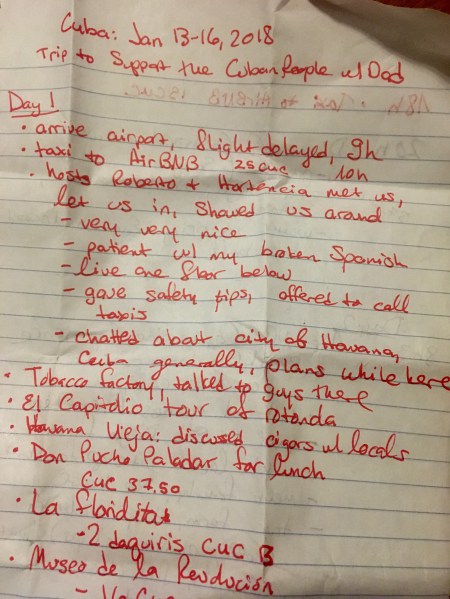
Example of “journal” kept in case of audit
For customs, U.S. Residents (citizens and legal permanent residents) over 18 or 21 are allowed to bring back (for personal use or gifts, but not resale) 1L of alcohol, 200 cigarettes, and 100 cigars. As with returning from any foreign country, U.S. Residents are limited to $800 total of goods brought back into the country for personal use and gifts. Therefore, even though you are allotted 100 cigars, if you purchase 100 Cohibas at $10 per cigar, you will exceed your $800 customs limit. To get around this you may split up items among your 18+ or 21+ family members and/or travel companions: e.g., if you want to bring back 100 Cohibas at $10 ($1000) and your wife wants to bring back 2L of rum ($20), you can each claim 50 Cohibas and 1L of rum for $510 each, which puts you under both the quantity and monetary personal customs limits.
In conclusion, it was considerably easier and cheaper to visit Cuba than I ever thought, so if you have any interest in seeing this beautiful country I would highly recommend it!
Love this post? Save it to Pinterest for later!
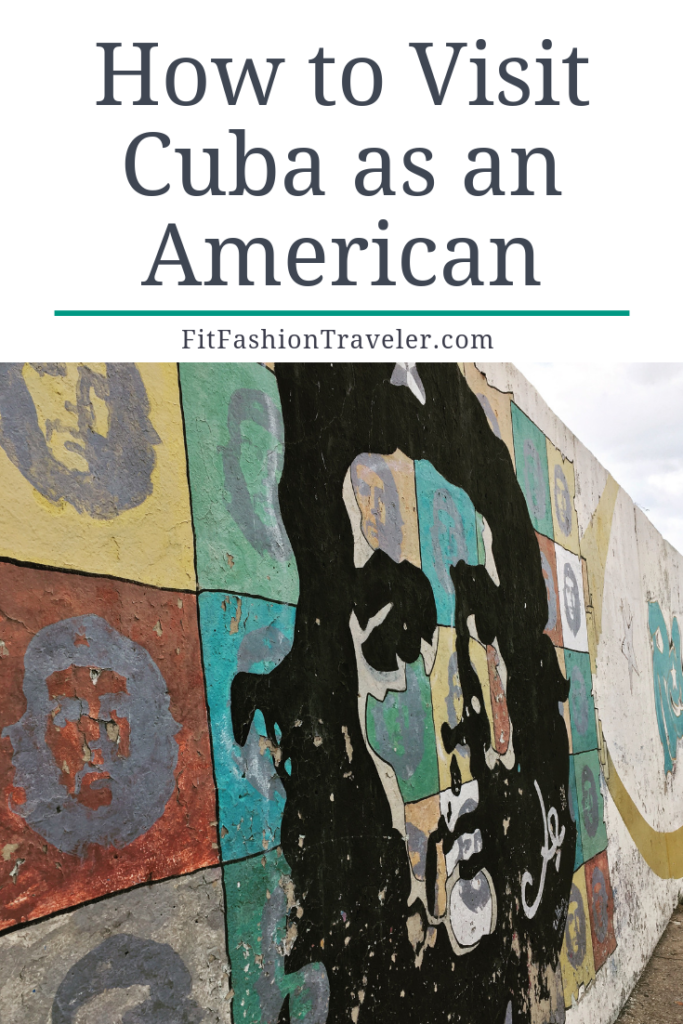

by Kelly | Mar 14, 2018 | Caribbean, Cuba, Day Trips, Havana, Travel
Cuba has been my top bucket-list destination my entire life, and this past January I made that lifelong dream come true with a weekend in Havana! Most Americans think Cuba is off-limits for travel unless you have family living there or want to go with a humanitarian volunteer group, but after my roommate and her friends visited in December I realized how easy it is to travel there legally.
Are you an American wondering how to visit Cuba legally without an expensive tour group? Check out my post on How to Travel to Cuba!
Starting the trip
This past winter was brutally cold in New England, so when I suggested to my dad that we check out Cuba instead of our annual Martin Luther King weekend trip to Mount Tremblant in Canada, he was completely on board. We booked our flights and AirBNB accommodations, created our itinerary, reserved our activities each day, and two weeks later were headed for Havana!
Old Havana
We arrived in Havana early Saturday morning. Our AirBNB host met us at the apartment and let us in early so we could drop our bags before wandering around the city. Our hosts, Roberto and Hortencia, were the most helpful AirBNB hosts ever! They spoke no English and were very patient with my broken Spanish as they explained the apartment and surrounding areas. Roberto even offered to give us a guided walking tour of the city, but seeing as my dad doesn’t speak Spanish and I was already exhausted from an hour of communicating with them, I wrote down Roberto’s suggestions and we were on our way.
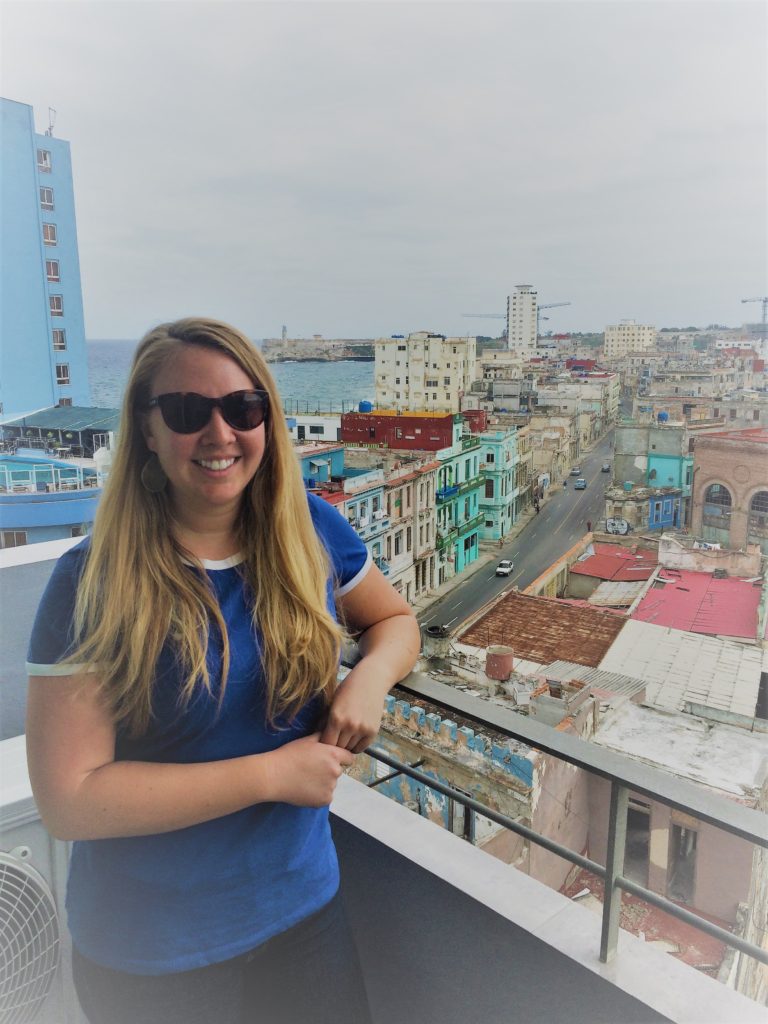
Photo from the AirBNB Balcony overlooking Havana and El Malecon boardwalk
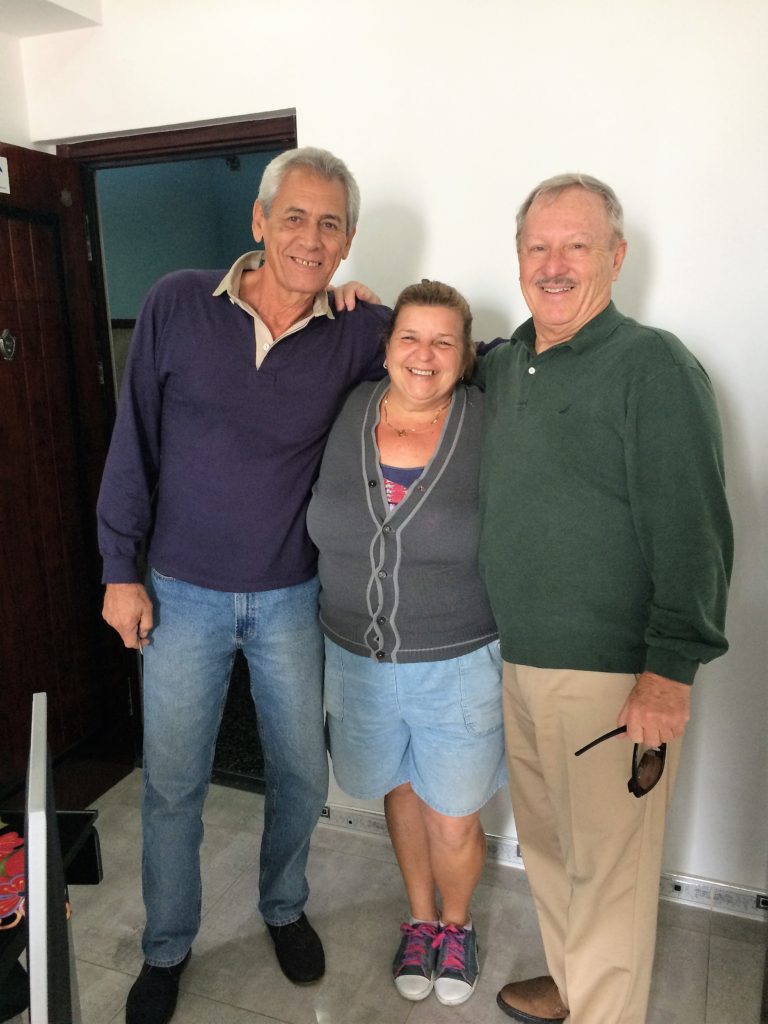
My dad (right) with our incredible hosts Roberto (left) and Hortencia (center)
Fabrica de Tabac
Our first stop was the Tobacco Factory (Fabrica de Tabac), which unfortunately was closed for repairs. We noted the prices of cigars for later and continued on our way. Note that cigar and alcohol prices are fixed in the country, so you will not get a better deal by shopping around, and if a local offers you a “better deal,” they are probably selling fake products.
El Capitolio
Next to the factory was El Capitolio, the capitol building and entrance to Old Havana. El Capitolio should look familiar, as it is modeled after the U.S. Capitol building. We went inside for a free tour of the rotunda, where the national symbols are on display as well as the tomb of the unknown soldier. I was most surprised to see the American flag on display along with all the other flags of North and South America, representing countries that helped shape Cuba’s history.
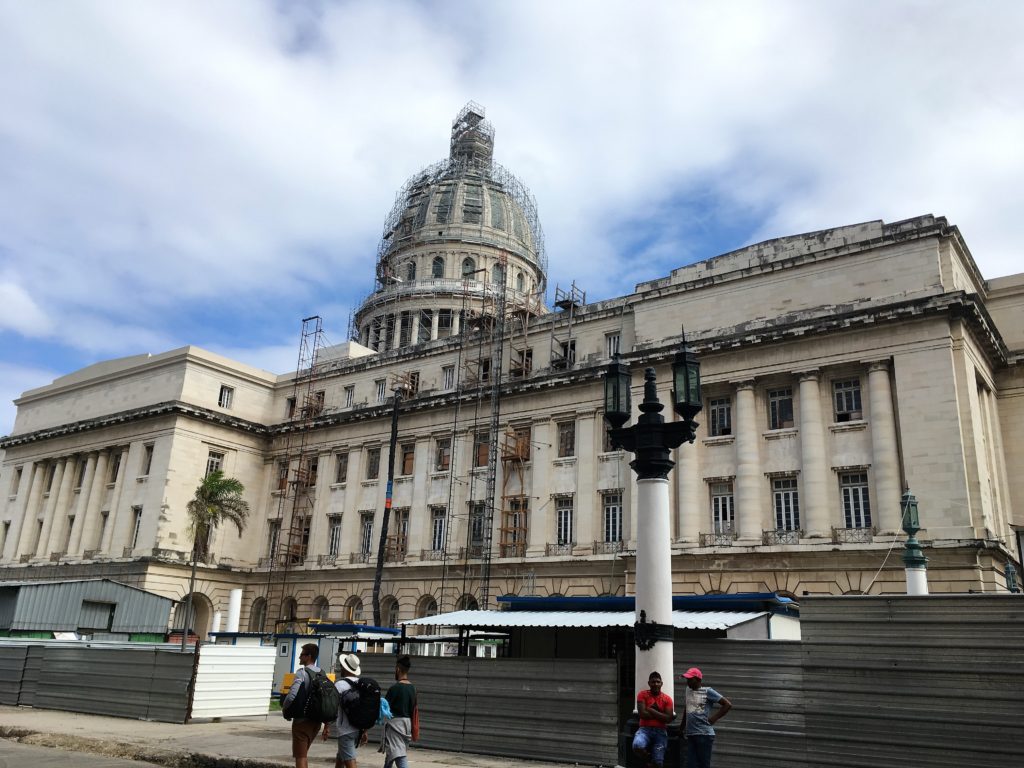
El Capitolio, under construction
La Floridita
Next we visited the La Floridita bar and restaurant, origin of the daiquiri and a favorite haunt of Ernest Hemingway, who lived in Cuba for many years. My dad and I each enjoyed an original daiquiri, which is lime-based and refreshing, rather than sweet like American strawberry daiquiris. If I were to return to one place in Havana for a drink, this would be it.
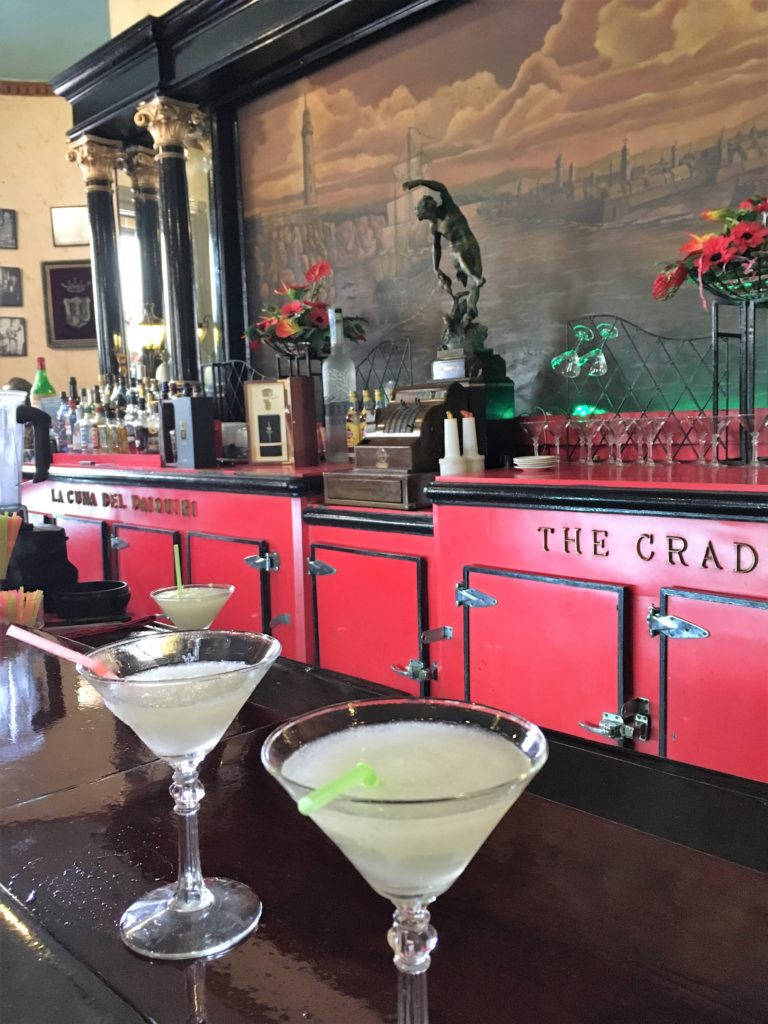
Museo de la Revolucion
After our drinks, we wandered over to the Museo de la Revolucion. Here, we learned so much about the years leading up to the Revolution before the January 1, 1959 overthrow of which the world is aware. There was also a lot of information about Che Guevara and Camilo Cienfuegos, two of Fidel Castro’s right-hand-men during the Revolution. After Cuba was won for the Communists, Che went to fight in Bolivia where he was killed by the CIA, and it is rumored that Camilo was offed by Castro shortly after he came into power to avoid a power struggle or a second revolution of the people more in favor of Camilo.
La Bodeguita del Medio
Continuing with our itinerary, we went to try a mojito on the roofdeck of La Bodeguita del Medio, the birthplace of the mojito, before venturing down to the Almacenes San Jose market. Here I found jewelry and beautiful artwork to purchase from the Cuban people. The market contains your typical souvenirs, so there is nothing particularly fancy, but it’s a fun place to look around and find something to pick up both as a memory from your vacation and in support of the local vendors.
Hotel Nacional
Our last stop of the day was the Hotel Nacional, a large modern, luxury hotel on the waterfront El Malecon boardwalk. We thought the hotel must be government or military owned, so we just walked around without purchasing anything, but we found out later that it is privately owned so it is possible for Americans to have a drink and make purchases there. The coolest part of the National Hotel is the bunker system in the back from the days of the Cuban Missile Crisis. My dad was old enough during the crisis to remember the crisis it happening, and his older brother was in the Air Force at the time ready to respond if an incident took place. With this perspective it was fascinating to hear my dad’s thoughts on the bunkers, the most interesting being the realization that the Cubans were just as afraid of Americans shooting missiles back at them as we were of being shot at from Cuba. During our trip we also learned that the Cubans had no control over the missiles: the largest Soviet military presence in Cuba occurred when the missiles were placed there, not because of the American threat, but to prevent the Cuban people from taking the missiles from the Soviets.
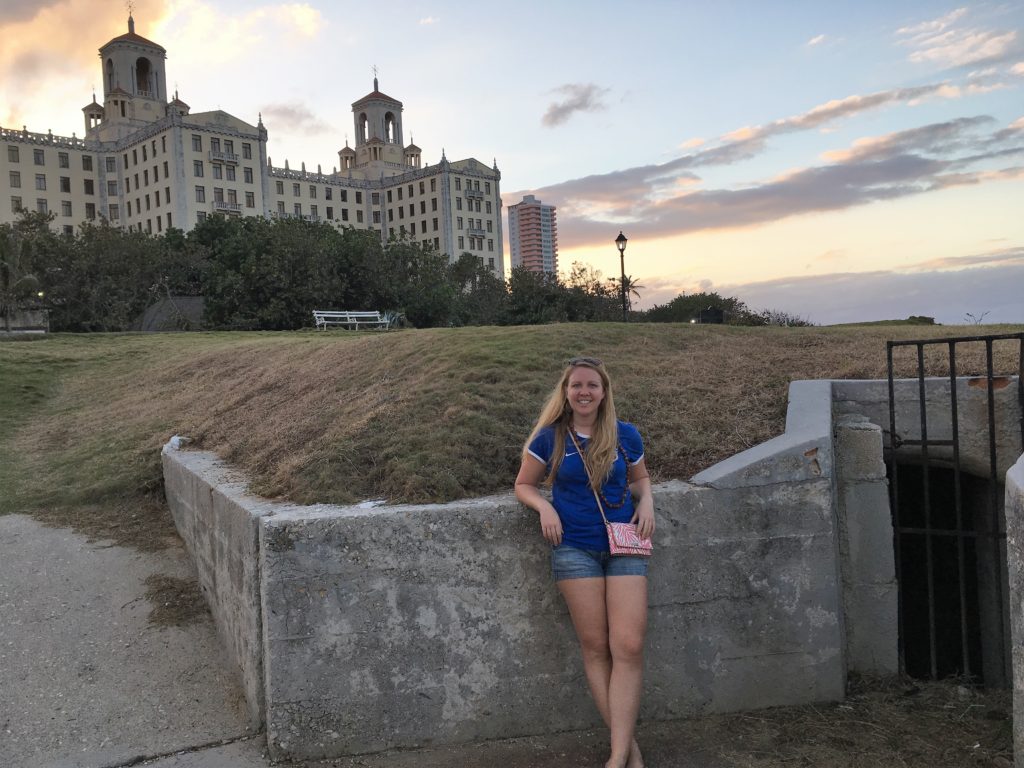
Night One Dinner
For dinner walked to a restaurant on the water front to enjoy a pitcher of sangria and the most typical Cuban dish, ropa vieja. Literally translated as “old clothes,” this dish of shredded beef and tomatoes had the perfect amount of spice and tenderness for me to say it was the best ropa vieja I’ve ever had! After dinner, our itinerary included a night out with live music, but we were so tired from the traveling and walking of the day that we went right to bed. We had also been thinking of visiting Club 1830 for salsa dancing, but it was raining and we were told that the club doesn’t have a roof, so we would be the only ones there if we went!
Interested in your own Havana Itinerary? Check out the article One Day in Havana.
Countryside Day Trip
Breakfast
The second day of the trip was filled with a 10-hour tour into the countryside to see how Cubans outside Havana live. We began the day with breakfast at Locos por Cuba, where we met our tour guides Alex and Leo, two young economics and political science professors at the local Universidad de la Habana. We also joined up with the four other visitors, a couple from San Francisco also in Cuba on the Support the Cuban People visa, and two friends traveling together from Florida and Maine who were visiting on an educational visa (they were establishing connections for a return trip with community college students later this year).
On the Farm
After a two-hour van ride to Viñales, during which the driver stopped at a true pit-stop – a guy standing on the side of the road selling food and drinks he kept in the woods behind him – we arrived at our farm for the day and met the local family. When Castro took over Cuba and implemented Communism, all families were given a house, and those in the countryside were also given land. Because of this, there are no homeless people in Cuba! However, there is also no money to buy additional property, so generations of families live in the same house their family was provided in 1959. On this particular farm lived the grandmother, the father and mother, and at least three children. The house contained exactly five rooms: a kitchen, a bathroom, two bedrooms, and a dining/living room. It was not a lot of space for a large amount of people, but the family didn’t seem to mind.
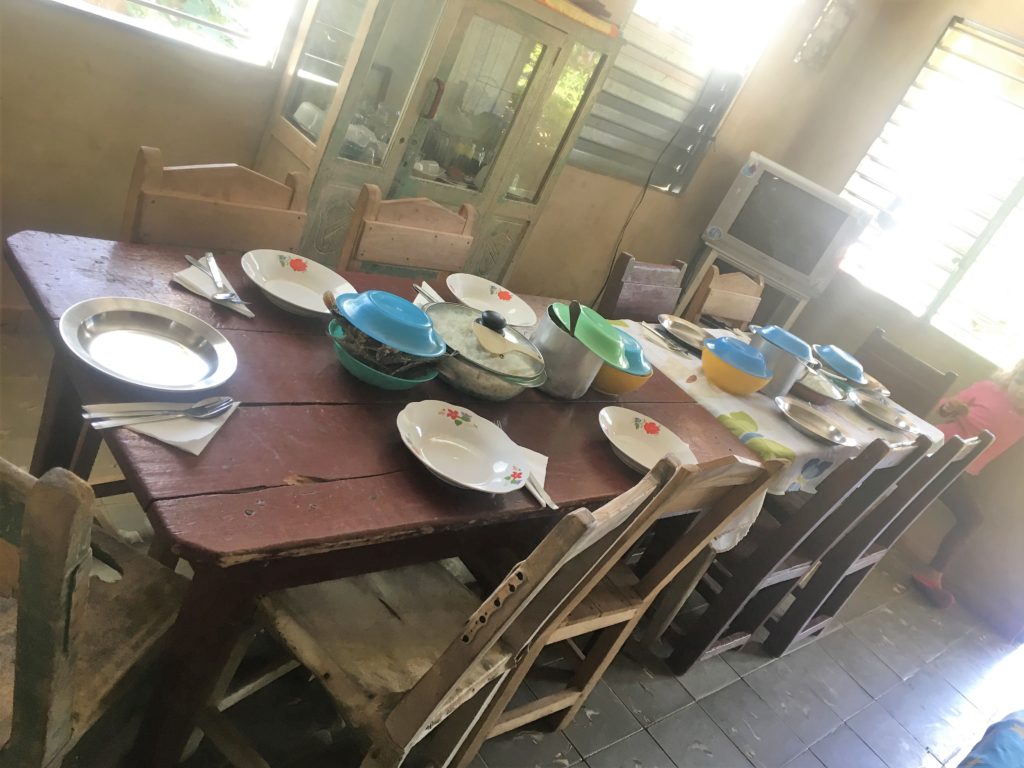
Table set for 9 by our gracious hosts in their living/dining room
Everything from the Land
We began our tour tasting the different fruits of the farm. The entire property is self-sustaining, with everything they need for consumption found on their own land. We tasted fresh oranges, plantain chips made in front of us from plantains picked from the farm, and coffee that was grown, harvested, roasted, and ground on-site. Even the water was collected and purified on the property, and the fish we had later for dinner was caught in the river running through the farm.
Exploring the Property
After exploring the area around the house, we went on a hike through the many acres owned by the farmer and his family down to the river and bat cave. We crawled our way through the bat cave until we were standing right under the bats: it was recommended we all wear hats for this part to avoid bat droppings on our heads.
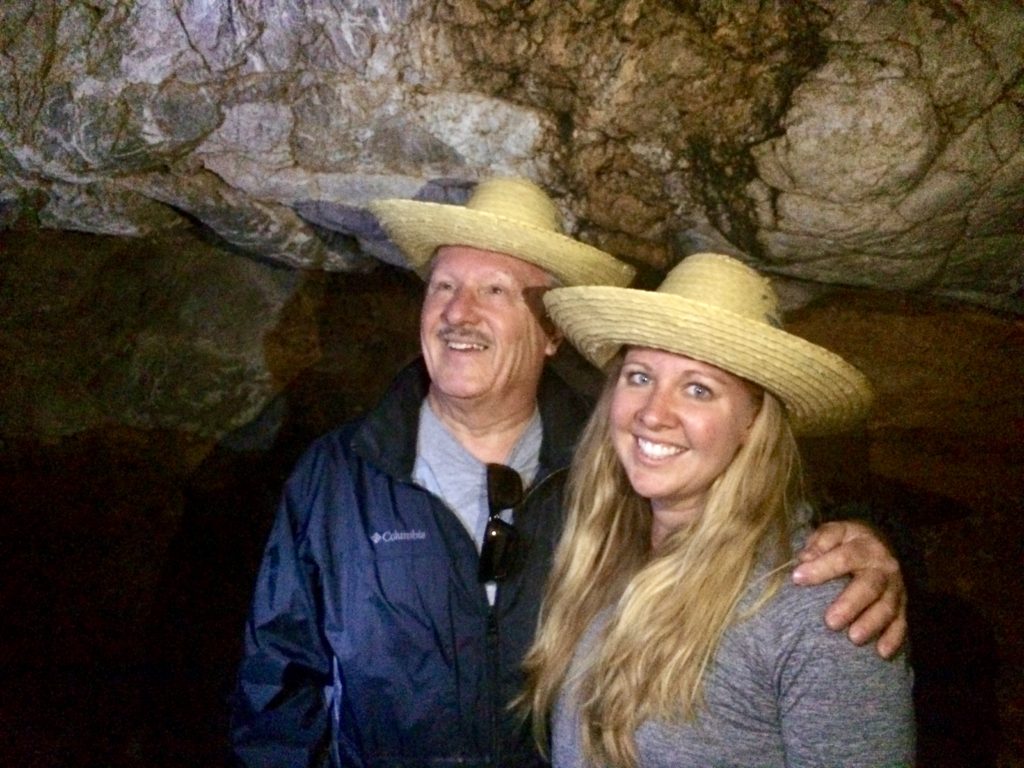
Smiling, but also afraid the bats a few meters above us would wake up and notice our presence
On the way back from the cave we stopped by the river for a swim and to learn more about life in Cuba from our guides and the farmer we were visiting. It was wonderful to hear our guides sharing their opinions, both positive and negative, about various aspects of Cuban life, economics, and politics. One of the guides stated that he would like to see more democratic and capitalistic features in Cuba, but also to maintain the free education, healthcare, and housing on which so many people rely.
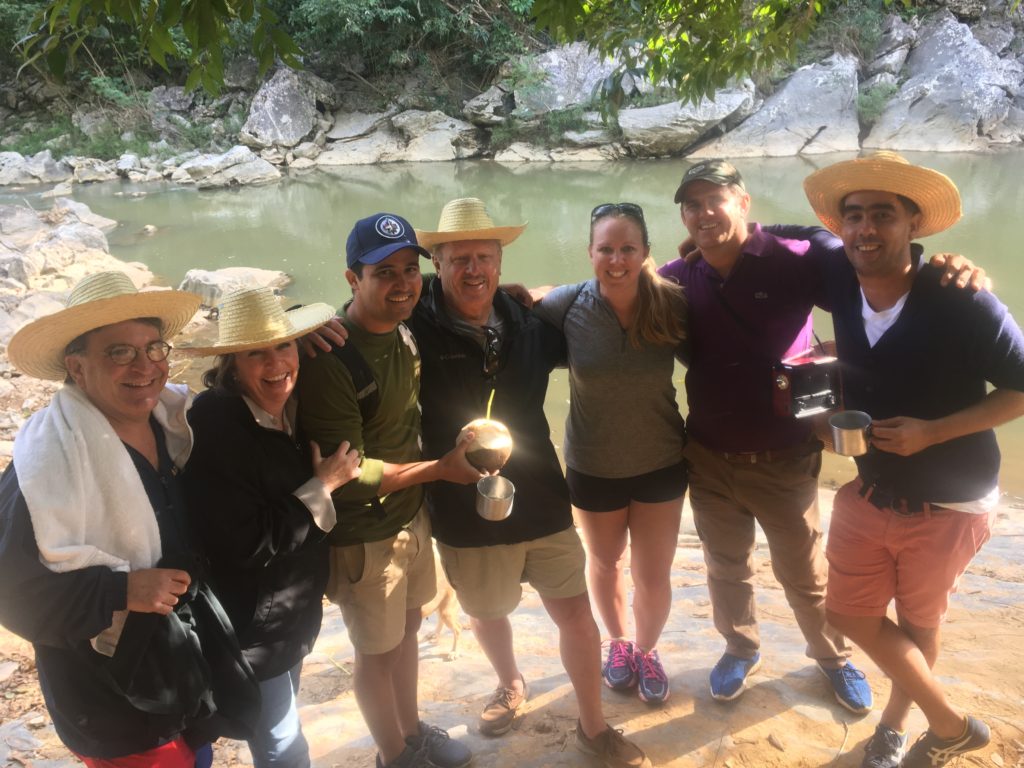
Family Dinner
Finally, we were invited to share a meal with the family before heading back to Havana for the evening. The experience we had that day on the farm is something I will never forget, and I definitely encourage anyone who visits Cuba to consider this experience!
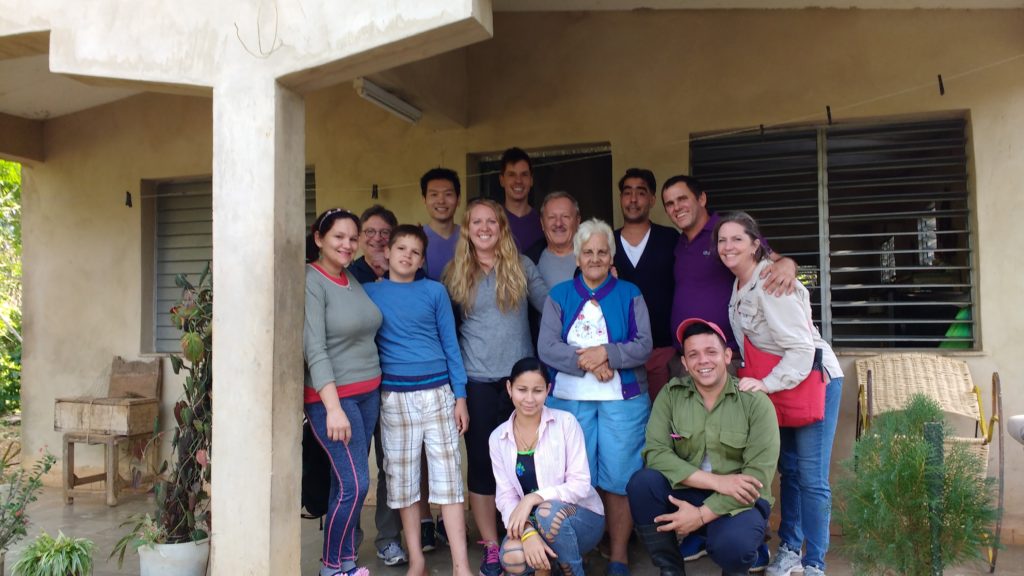
Fitness In Havana
Our final full day in the country included a 5-hour bike tour of the city in the morning, followed by rooftop salsa dancing lessons from locals in the afternoon. I was really looking forward to this day, especially the salsa dancing, but unfortunately got sick the night before. Regardless, I still went out and made the best of it, though every time my dance instructor asked if I was ok, all I could replay was “sí, sí, estoy bien,” rather than “I’m just trying not to throw up on you.” Please learn from my mistake and don’t let your guard down on any raw or potentially unwashed food in the country: I think that may have been my downfall!
Morning bike tour
Taking a bike tour allowed us to experience many areas of Havana that would have been difficult to get to from our AirBNB. The start of the tour was in the Vedado area of the city, which gave us the opportunity to ride in one of the classic car taxis! While my dad was very disappointed to learn that the only original part was the body, and that the engines were all old Soviet car engines from the 80s and the 90s, we were happy to get our old-car ride in for the trip.
The main stops of the bike tour included the Havana Forest, Columbus Cemetery, Revolution Square, Old Square in Old Havana, and El Malecon. Our tour guide was another professor from the Universidad, and our tour companions were two young British girls in Cuba on holiday for a week. Taking a bike tour in Havana is a great way to experience a large part of the city while also getting in your vacation exercise!
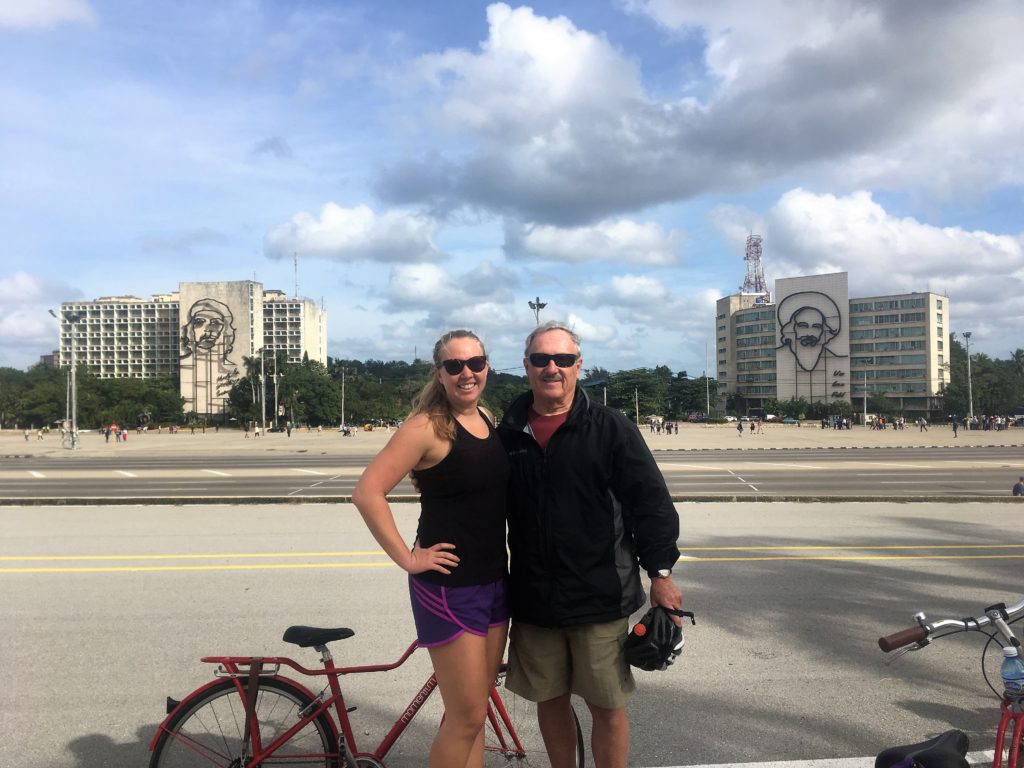
Metal sculptures of Guevara and Cienfuegos flank Revolution Square. As Castro would stand at the front and make his speeches to a filled square, his two other revolutionaries would be looking back at him.
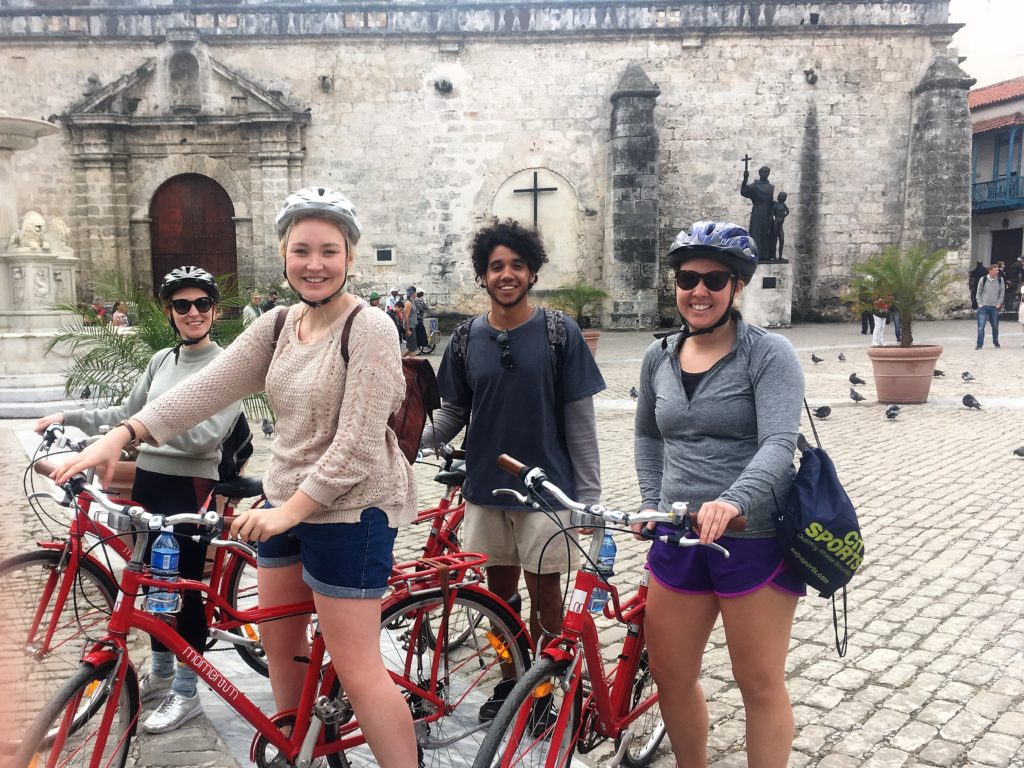
Two British companions and our tour guide in Old Havana
Afternoon Salsa Dancing Lesson
For our last afternoon, we had signed up for rooftop salsas dancing lessons. We were picked up from our AirBNB, brought to the studio, and matched up with partners based on our gender and abilities (I have many years of basic salsa experience as well as other dance experience, while this was my dad’s first time learning it). Having a private lesson for over 2 hours was so much fun! My instructor began by dancing with me, and when we would try a move I was clearly unfamiliar with he would stop, teach me the move, and then continue dancing to practice. I felt like I was just out dancing normally, and yet had a dance partner who wouldn’t get frustrated if I was unfamiliar with something or messed up a move, but instead had unlimited patience to continue teaching me. My dad reported a similar experience with his instructor. After class we were returned to our AirBNB by the same driver.
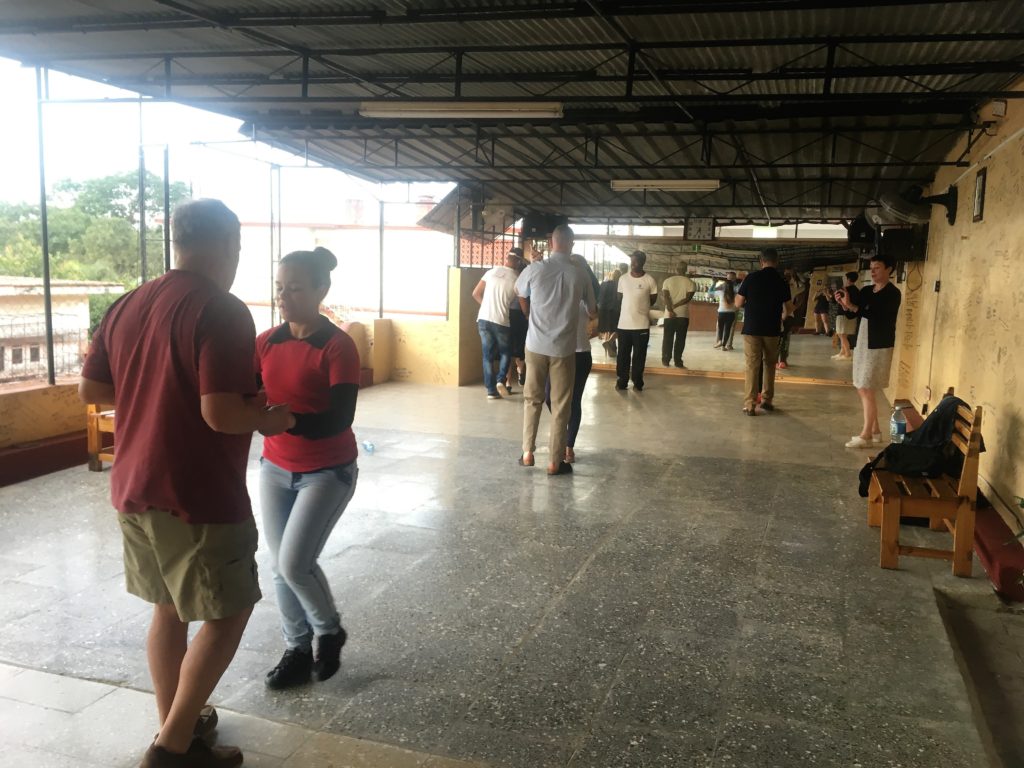
Final Dinner: La Guarida
We made it a point to book reservations far in advance for dinner at La Guarida, considered one of the best restaurants in Havana and the place where anyone who’s anyone stops by at least once when they’re in Cuba: Madonna celebrated her 58th birthday here, and Beyonce dined here with Jay-Z on their most recent trip to the city. The building – like most in Havana – looks on the outside like it was once beautiful but is now about to crumble down on top of you. Once you get past the bouncer, you climb up five flights of crooked marble stairs past empty floors that are now ghosts of their former glory and opulence. However, once you get by all this and reach the restaurant on the top floor you are in for a wonderful surprise: La Guarida would be considered fine dining even in the United States. The decor is contemporary and the space is small, with many different rooms and two small balconies seating diners, but you feel special from the moment you arrive, and the food and drinks are incredible! While I was still somewhat sick from the night before and did not get to enjoy the restaurant as much as I wanted to, I highly recommend it and cannot wait to go back and try it again next time I am in Cuba.

Final Thoughts
Cuba is not off-limits for Americans, so long as you don’t mind an active vacation that involves staying in an AirBNB and eating in local, family-owned restaurants. There are some precautions to take and things to know before you arrive, but the people are super friendly, the city of Havana is safe, and the country of Cuba has such a rich, unique culture that must be experienced firsthand.
If you are interested in staying in the AirBNB or participating in the activities described above, you can follow the links below. First-time AirBNB users can get a $40 credit here: www.airbnb.com/c/kellys8303.
AirBNB lodging
Countryside Experience
Bike Tour
Salsa Dancing Lessons
Love this post? Save it on Pinterest for later!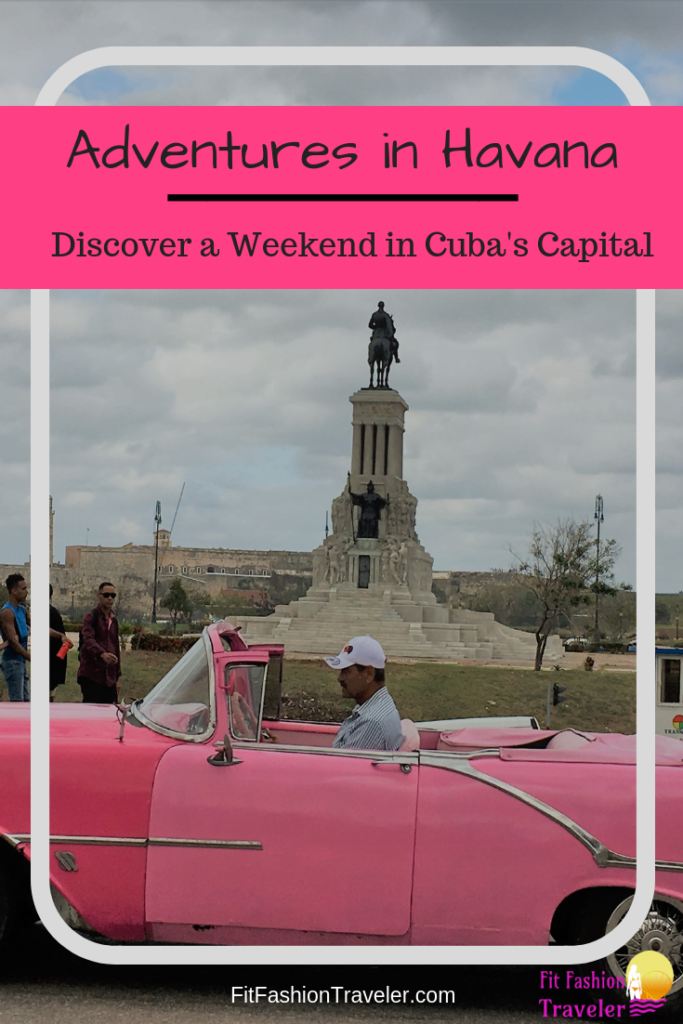

by Kelly | Feb 27, 2018 | Bermuda, Itineraries, North America, Travel
Use the following itinerary to set your schedule for a day of your vacation in Bermuda: this is especially useful for your one full day on the island if you are visiting via cruise ship!
7:00 AM: Breakfast
To see the entire island in one day you’ll need an early start. Grab breakfast either on board your cruise ship or at your hotel. Don’t forget to take a few extra cereal boxes and fruit for snacks throughout the day!
8:00 AM: Depart for the Beach
Purchase your all-day bus pass first thing: you’ll need it to hop on and off the public buses and ferries throughout the day. Take the bus right to Horseshoe Bay beach, one of the quintessential pink Bermudan beaches! If you want a stunning view of the island on the way you can get off a stop early (if coming from the Royal Navy Dockyard) and walk up to Gibbs Hill Lighthouse.
If you’re not ready for the beach first thing in the morning, you may skip this stop and instead visit Tobacco Bay beach at the end of the day. Note that if you choose this second option your timing for the day will be earlier than listed below, leaving extra beach time at the end of the day.

Pink, sandy beaches of Horseshoe Bay
11:00 AM: City of Hamilton
Arrive in Hamilton just before lunch to see the main city on the island. This is a hot spot for shopping, especially for the famous pink sand jewelry sold in a number of jewelry stores around town. Classic vacation souvenirs are also available here, including apparel that can be found in a Vineyard Vines store dedicated almost entirely to Bermuda. You may choose to enjoy lunch at a restaurant along the water, or wait until your next stop to dine at the Swizzle Inn.

12:30 PM: Hamilton Parish
Disembark from the bus at the stop for the Swizzle Inn. Here you can enjoy the infamous rum swizzle right where it was created! The drinks are delicious, but be warned that they are also strong. You can have a full lunch here, or just eat a few conch fritters to hold you over until dinner and temper the drinks.
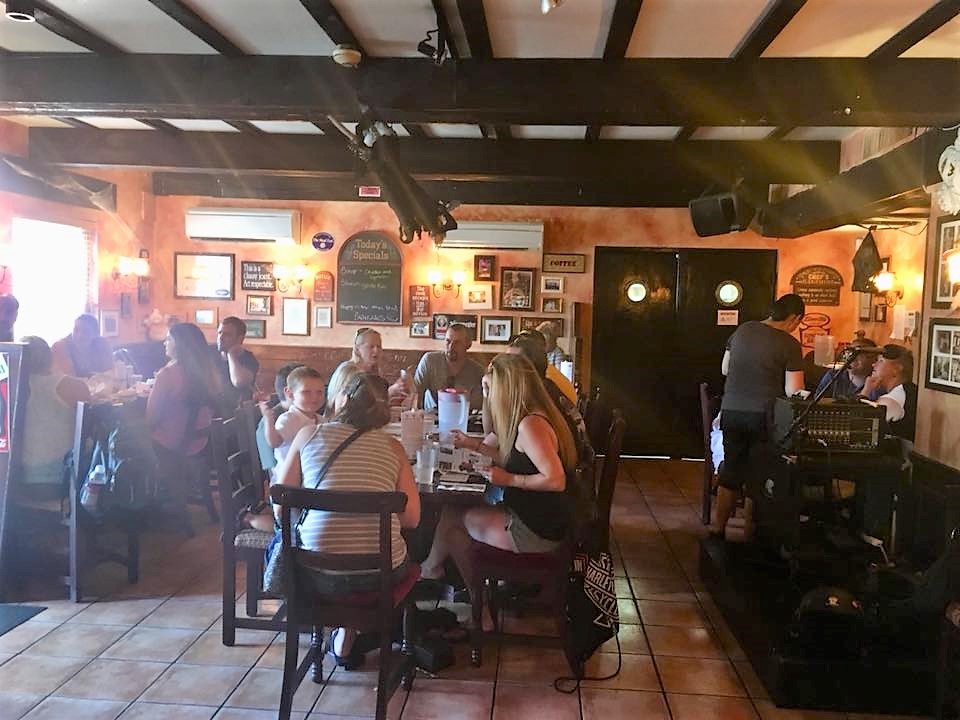
After your rum swizzle, forego the Crystal Caves and walk over to the Grotto Bay Beach Resort and Spa for some spelunking and cave swimming. Note that the grounds are technically reserved for guests, so to access them you must act as though you belong. Use the path to the left of the front lobby to walk around the building and go down the path towards the water, spa, and caves. The entrance to the cave is well-marked, just before the spa, on your left. The water is somewhat cold but the swim is well worth it! If you continue walking up past the swimming hole there are more caves to explore: the first few are lit but the cave system looks like it could go for miles and could be explored with a flashlight.
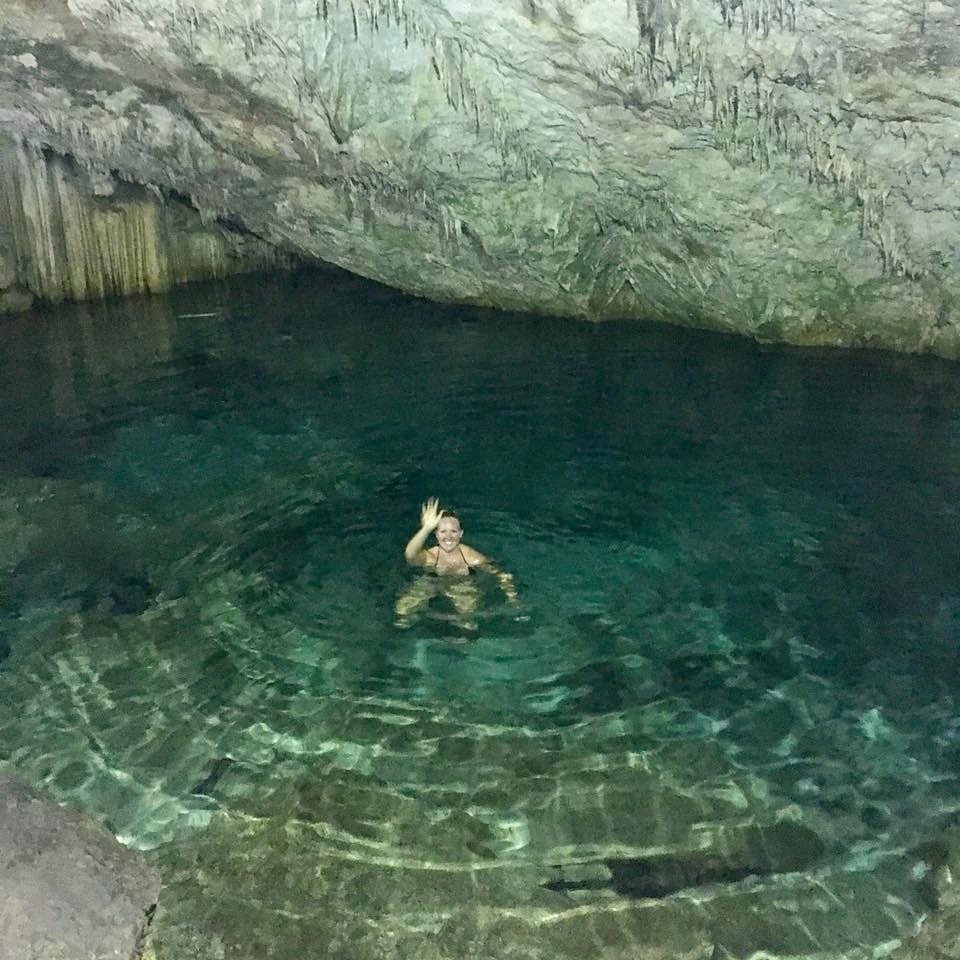
Your final stop in Hamilton Parish is another short walk away at the Blue Hole. Enter Blue Hole Park through a parking lot and walk along the path past some caverns until you get to the swimming hole. There is a platform built over the water to stand on and leave your belongings if you decide to venture in. You can enter the water one of two ways: slowly on the left side of the platform or by jumping from the 10- or 15- foot cliffs up the path on the right side of the platform! The water under the cliffs is at least 20 feet deep, and as of October 2017 there were no underwater obstructions. Use the rocks on the other side of the platform to get out of the water and back to your belongings.
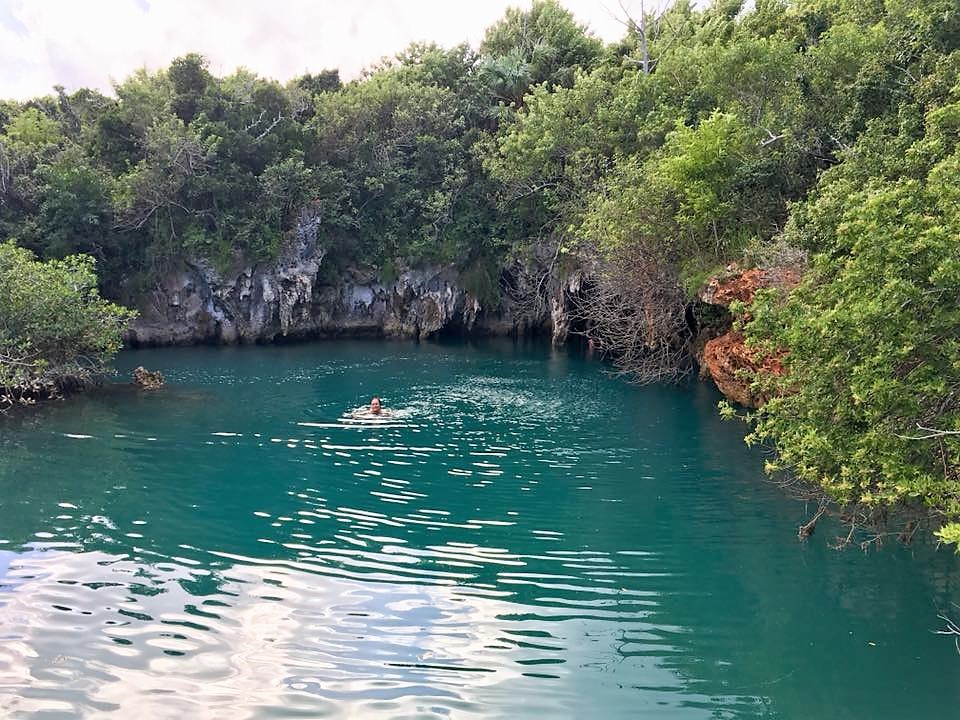
4:00 PM: St. George
Take your final bus ride to the town of St. George on the North side of the island. Have a look around the town center, and then head for Fort Saint Catherine. It’s a bit of a hike up to the fort but you should have plenty of time to get there, look around, and get back to catch the last ferry to the Royal Naval Dockyard. If you chose to skip the beach earlier in the day, stop at Tobacco Bay Beach on your way back from the fort for some music, sand, sun, and swimming.

Tobacco Bay Beach
5:30 PM: Royal Naval Dockyard
End your day back at the dockyard where you can explore the shops or take a short taxi ride to Sea Glass Beach to look at the mounds of sea glass on shore as well as the creations left in cement.

7:00 PM: Dinner
Return to your ship if you are on a cruise, or to your accommodations to get ready for dinner and the rest of your evening!
*Like what you see here? Contact me for your own customized travel itinerary!
Love this post? Save it on Pinterest for later!
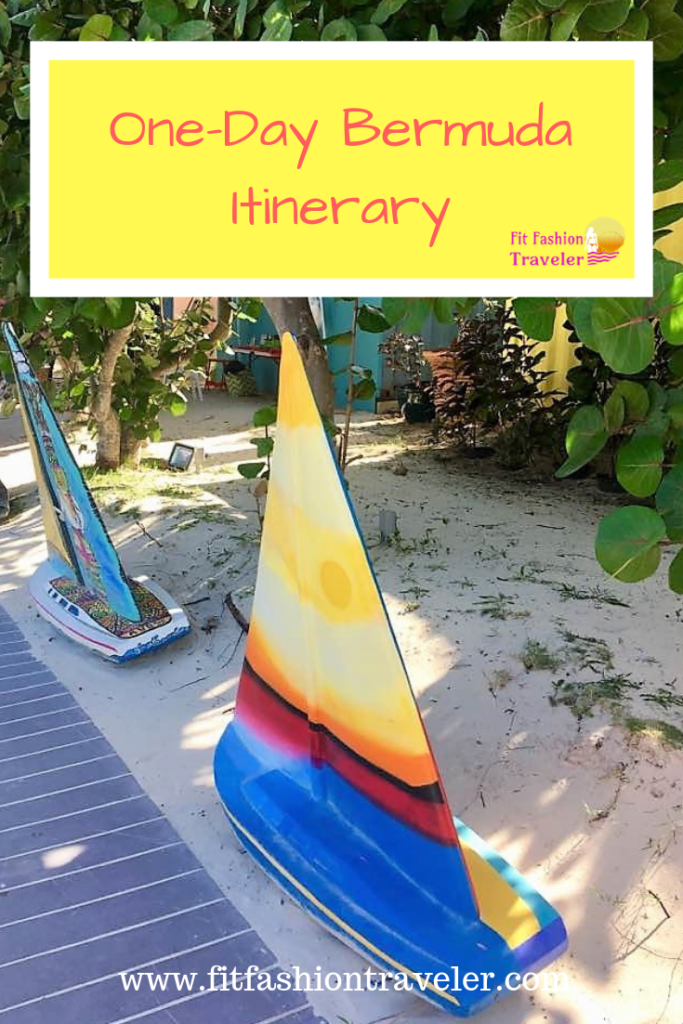

by Kelly | Feb 23, 2018 | Bermuda, North America, Travel
Last October I joined some of my family members for a 7-day, 10-person family and friends cruise! My aunt, uncle, cousin and her family, and three family friends flew out to Boston from Chicago to embark on the Norwegian Cruise Line ship the Norwegian Dawn with me on a cruise to Bermuda. Being an only child, most of my family vacations growing up consisted of traveling with just one or both of my parents, so having such a big group was a much different experience for me, and one that I certainly enjoyed!
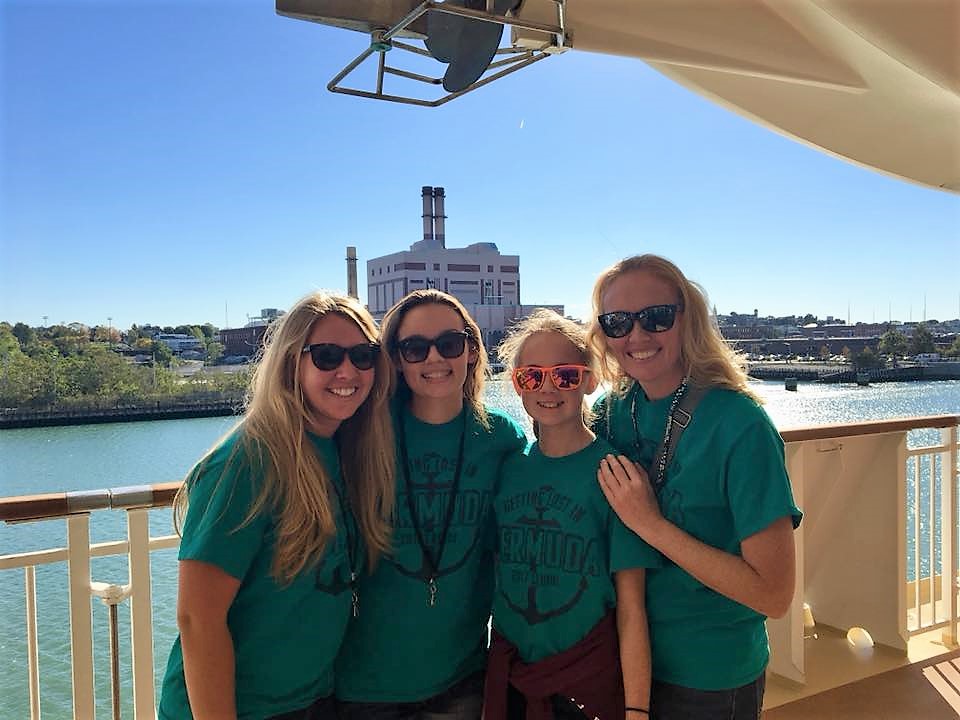
Leaving port, wearing our matching Bermuda shirts: key for locating each other on the first day!
This post will focus on adventures and advice on board the ship that can transfer to almost any cruise, especially those on the Norwegian Dawn. In my next post I’ll provide a one-day itinerary of Bermuda and some tips and tricks for the island.
On Board the Ship
Our cruise consisted of three full days at sea, one on the way to Bermuda and two on the way back. On the outbound trip the weather was warm and sunny so we were able to spend most of the day sitting by the pool and enjoying our unlimited drink packages, which are totally worth it! However, the return to Boston was marked by stormy skies and rough seas, thus requiring us to stay inside and partake in many of the on-board activities offered by the entertainment crew. We still made the most of it and had an awesome time on board.

Here are some of my top recommendations for cruising on the Norwegian Dawn.
Food and Drink
If you have options for free packages with your cruise, the all-inclusive drinks and specialty dinners are absolutely worth it. The bar tenders will make any drink you want (don’t like the pre-made margarita mix? Ask for a cocktail made with just tequila, triple sec, lime juice, and simple syrup) and the food in the specialty restaurants is unique and delightful. The best part about the all-inclusive packages is that you can remove the stress of thinking about the prices of these things from your vacation!
For those of you concerned about how to stay healthy with all-inclusive food and drinks, I’ll share a secret with you: one of the keys to eating in an all-inclusive environment is recognizing that it is not “all-you-can-eat” but instead a break from worrying about price. At an a la carte restaurant perhaps ordering two fried appetizers would be cheaper than the grilled salmon and your favorite vegetable, but in an all-inclusive situation you can go for the salmon with no worries. The same goes for the drinks: if you want to try the rum swizzle and then decide it’s not for you after two sips, you can ditch it without thinking about the $14 you may have just paid for it in order to spend your calories on something you will enjoy.
On the cruise, my travel companions and I appreciated having the all-inclusive option because it allowed us to enjoy a welcome cocktail when we first boarded, drink any wine we desired with dinner, and try a variety of mojitos from the mojito bar on the top deck. Keep in mind when ordering wine that the all-inclusive drink package will give you unlimited glasses, but you will be charged for a bottle! Instead of ordering a bottle of wine for dinner, we would each order a glass of the same kind of wine, and it was completely free. We also dined at two specialty restaurants, the Bamboo Asian Restaurant (which has free options) and Cagney’s Steakhouse, both of which I would highly recommend. Be warned that portion sizes in the dining rooms are smaller than on land: don’t make the mistake I did the first day at lunch thinking I could subsist on just a soup and appetizer salad!
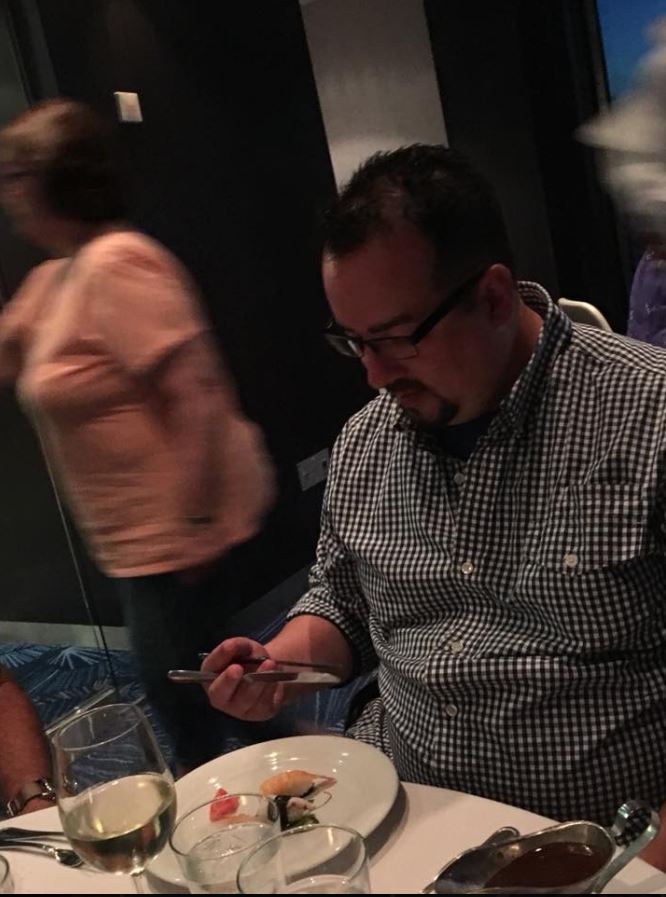
Checking out the unfortunately small sushi appetizer and debating eating it with two knives since we were not provided chopsticks
Attire
One of the first questions I always ask whenever I go anywhere is “what should I wear?” For the most part on the cruise, typical vacation or warm-weather attire will suit you well. If you plan to dress up, be sure that you wear shoes that can withstand walking on a rocking boat (aka no stilettos). There are no formal nights on Norwegian Cruise Lines, but you will not be out of place if you decide to throw on a cute dress or a collared shirt. In fact, in order to dine in the Venetian Dining Room at dinner time you must be wearing either pants or a dress/skirt: you will be turned away if you are wearing shorts, as our party learned the hard way. There are many other dining options so you will not be out of luck if all you have are shorts, but keep this in mind and pack at least one nice outfit if you want to keep your options open.
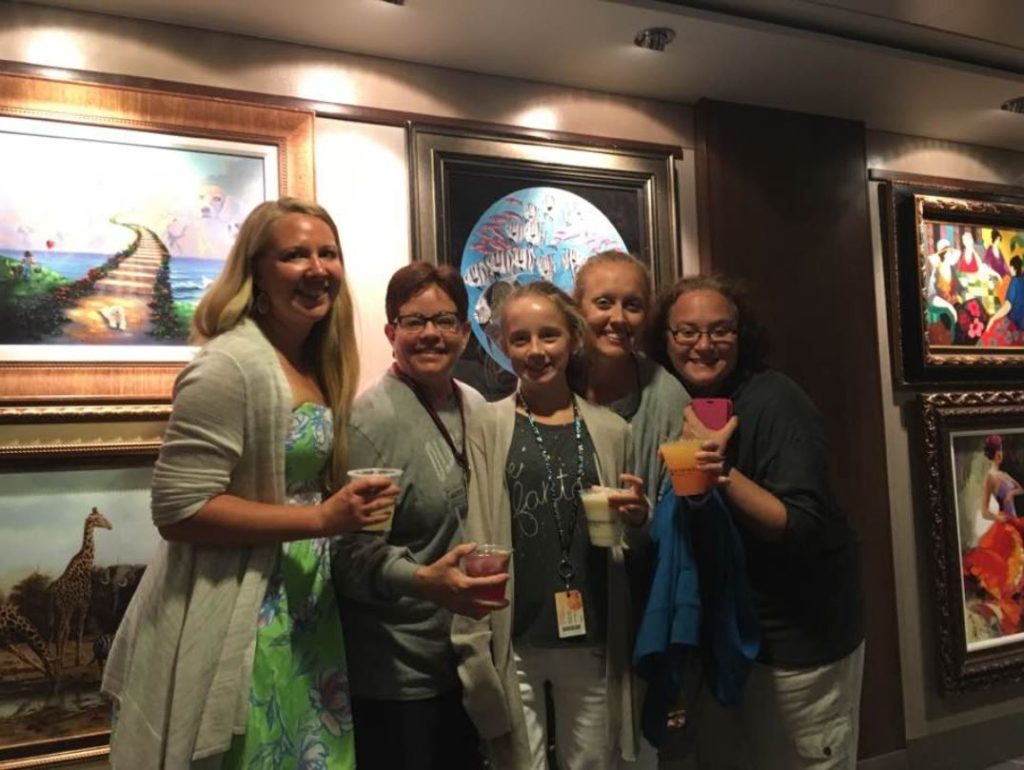
Our typical evening attire
The other special attire recommendation is to bring something white for the White Out party, hosted on the top deck the night you leave port. Usually the pool deck is relatively quiet at night, but for the White Out party the ship’s Cruise Director brings out live music and the dancing entertainment crew for a huge black light party! You can still participate if you are wearing colored-clothing, but most people will be wearing white, and it’s fun to get in on the festivities with them.
Activities
I’m sure thinking of cruise activities you immediately pictured yourself sitting by the pool all day while at sea, maybe reading a book, listening to music, and occasionally dipping into the water. Almost everyone else reading this also pictured the same thing, so you’ll either have to arrive poolside early to stake your territory or pick different activities to entertain yourself while at sea. Even if you do claim a coveted poolside chair, your space in the water will be limited.

One alternative is to spend some time in the gym or the spa. The gym on the Norwegian Dawn was incredible! They offered classes in their studios (some which cost money), and had a full set of cardio and strength machines as well as free weights. I made a commitment to go to the gym each day we were at sea and do either a HIIT, Cardio Dance, or Cardio Kickboxing workout. Two of the three days I used the studio because it was unoccupied and also had the most incredible views of the sea in its floor-to-ceiling, wall-to-wall windows. If you are able to make this type of commitment, as well as commit to taking the stairs instead of the elevator (saving time as well as calories) and practice the stress-free version of all-inclusive food and drink options, you could have an awesome vacation and come back a couple pounds lighter like I did! One thing to keep in mind if you do go to the gym is that the ship will be rocking, so this may not be the best time to practice your static squat.

One of two gorgeous studios in the gym
Another activity option is to check out the daily schedule of activities around the ship and pick a couple that appeal to you. Because my travel group was so large, we were able to attend the activities we wanted, usually with two or three others from our group, and then reconvene for dinner in the evening. I was drawn to some of the travel trivia games, such as “Flags of the World” visual trivia, my aunt attended all of the arts and crafts options, and my niece was excited to help with the towel-folding demonstration.
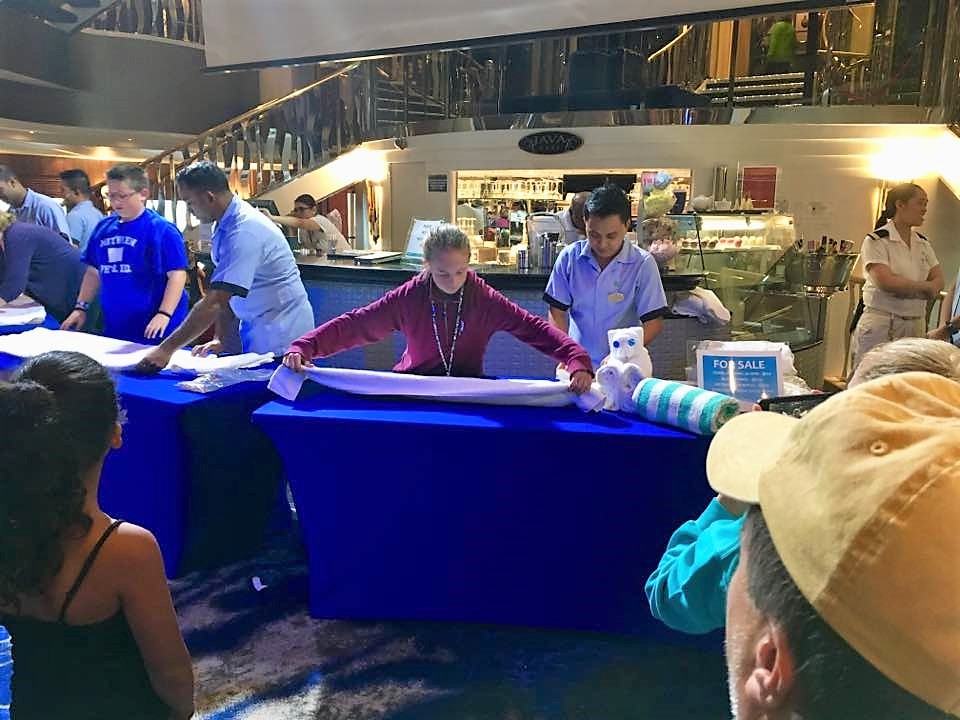
The evening entertainment is also plentiful, and you can’t go wrong with whatever you choose. We enjoyed the performances by the entertainment crew, comedy shows by Chicago’s Second City cast, and demonstrations by the resident illusionist. I was particularly excited for the Sunday night entertainment because the week I was on the cruise was the week the American football team the New England Patriots were playing a Super Bowl rematch against the Atlantic Falcons, and because the cruise left out of Boston, the game was being shown in the Atrium on a jumbo screen! A few of the ship entertainers hosted a pre-game tailgate in the Atrium and the Irish pub overlooking the Atrium, then all the Patriots fans on board were able to watch the game and cheer together as we were once again victorious over Atlanta. I even made friends with other young adults from Boston once my Midwestern family became bored with the crushing blow the Patriots were serving the Falcons. My one regret from that night was not realizing that everyone else would be donning their Patriots apparel: I hadn’t even thought to bring it, as I hadn’t realized what a big deal the game would be while on vacation.
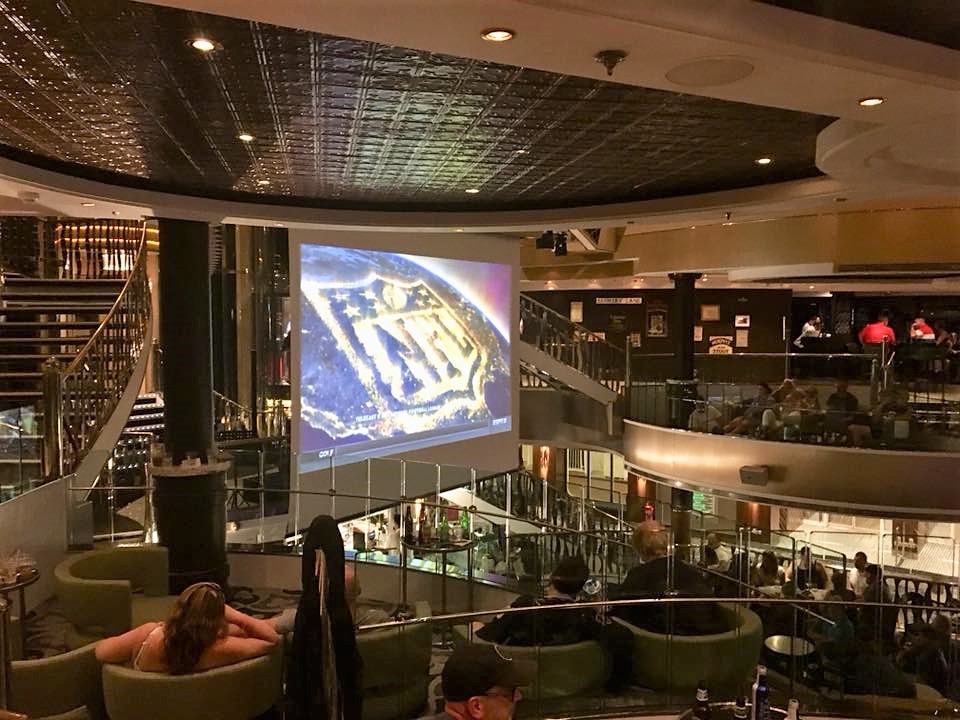
Cruise Advice
My #1 recommendation is to download the NCL app to your smartphone before you even get to the ship. Once you’re on the ship, pay the $10 per person for the on-board communications in the app. It was so much easier communicating plans among the group using the app communications rather than our original plan of writing notes to slide under each others’ doors and hope the other people saw the note. The app will also give you the schedule of activities for each day of your trip, restaurant hours, and any other logistic information you need. If you decide to purchase WiFi, you will do this through the app as well.
My second recommendation is to forego the WiFi and enjoy your disconnected vacation. If you need to purchase WiFi, purchase the cheapest plan, turn it on to quickly check your email, send a text, and post to Facebook, then go back to the website on which you turned it on and turn it off again. This will allow you to conserve your purchase and hopefully stick to the lowest paid plan, which was $25 when I went, for the entire trip.
Another consideration is to try to select on-board activities that are not located in Gatsby’s Champagne Bar. I was disappointed with how the Champagne Bar was connected with the cigar lounge on board. Even though the smoking area was completely enclosed, the smell still eked out after a while. My 10-year-old niece and I enjoyed a few activities in Gatsby’s, like making flower crafts and learning Filipino phrases, but we couldn’t stick around too long because of how awful the smell became.
Finally, my most fun advice: every day when you return from the island, put your bathing suits on, grab a drink, and head right for the hot tubs. There were almost no people there at this time because everyone else was getting ready for dinner, so we had the hot tubs to ourselves to relax and enjoy before beginning our evenings. It was the perfect end to each day, and something not to be missed. Cheers!

Love this post? Save it on Pinterest for later!
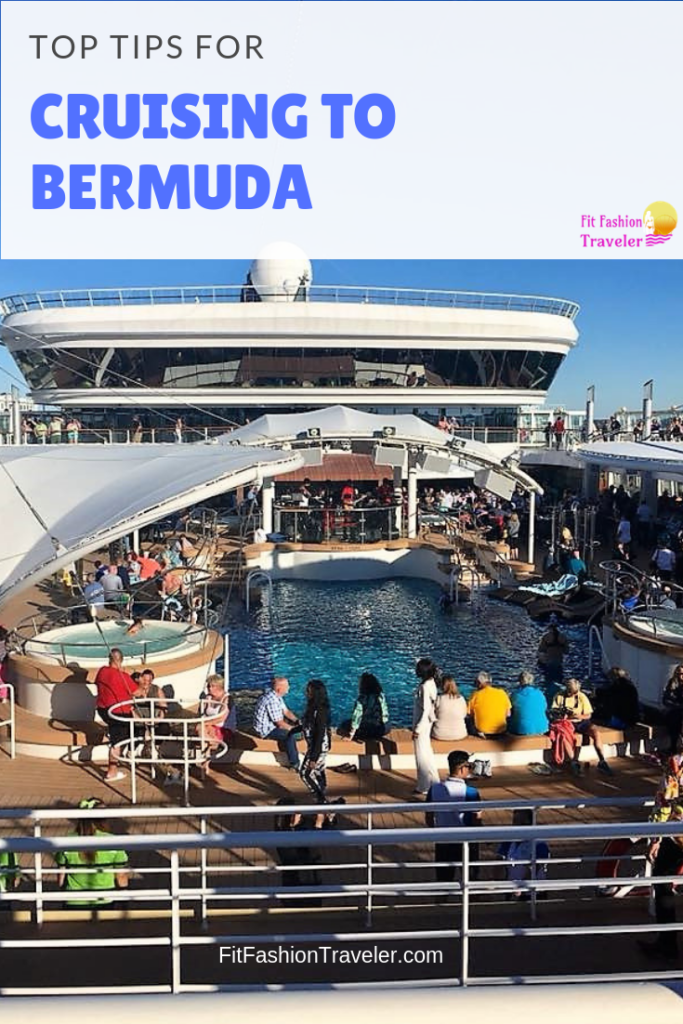
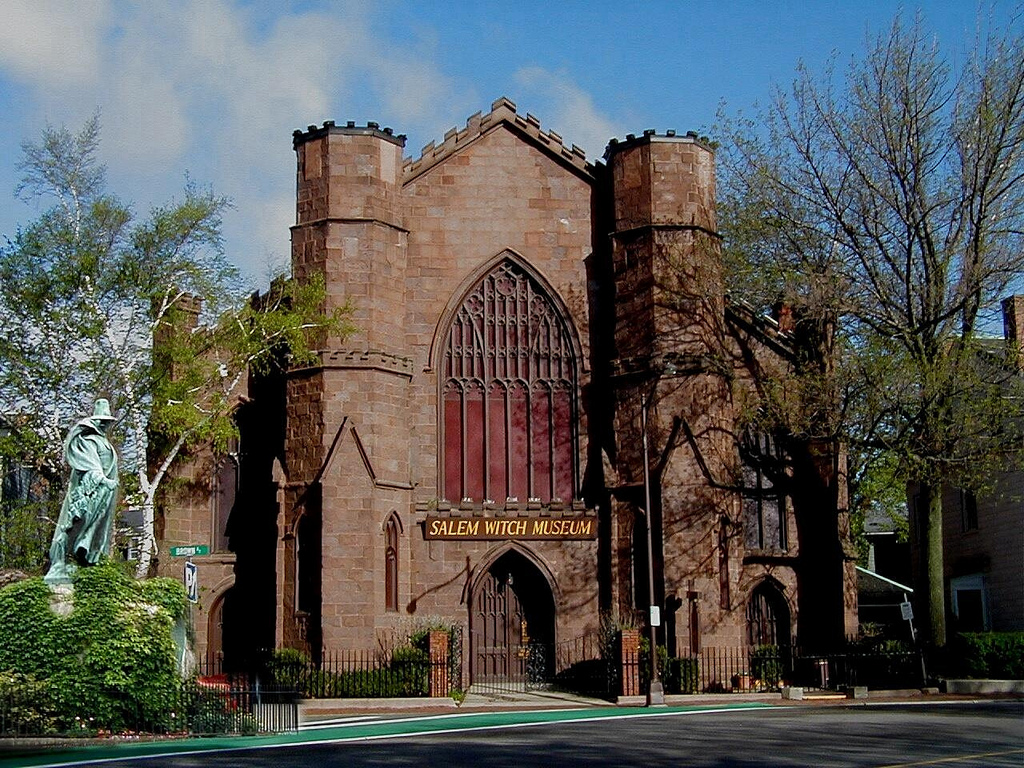
by Kelly | Feb 15, 2018 | Boston, Day Trips, Massachusetts, North America, Travel, United States
The city of Boston has a ton to offer, but if you want to get away for a day, there are exciting things to do in all directions: North, South, West, and even East!
Some of my favorite day-trip destinations from Boston are the Harbor Islands, the Cape, Patriot Place, Wrentham Outlets, Gloucester, and the Nashoba Valley Winery. If you have time, they are all worth checking out. However, I want to highlight a place I know well that is merely 30 minutes North of Boston: Salem, Mass.
Welcome to Witch City

Bewitched statue in the center of Salem
If you hop on the commuter train at North Station or drive up Route 1 for a half hour you may end up in historic Salem, home to the Salem Witch Trials of the 1600s. Salem embraces its history of witchcraft and has many witch-related stores on pedestrian-only Essex Street. It also offers year-round haunted or historical walking tours and invites visitors to see its Salem Witch Museum at any time of the year. If you really want to experience Salem in full swing, try spending a day or a weekend there in October. Throughout the month, the town brings in street performers and vendors, features carnival rides, hosts a parade on October 1 to kick off festivities, and lights off fireworks on Halloween. Almost all visitors dress up in costume, especially on Halloween, so this is the perfect time to dig out your favorite werewolf, vampire, or even witch costume!
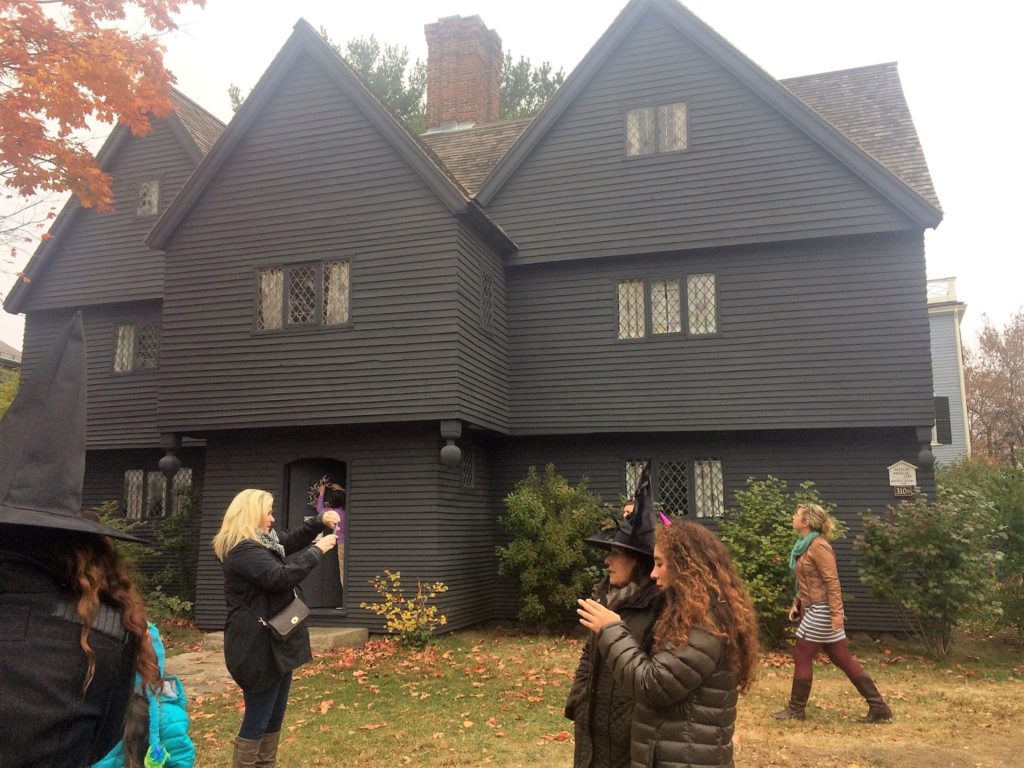

You can even take a self-guided walking tour of locations seen in the 1993 film “Hocus Pocus”: here we are in front of the Ropes Mansion!

If Halloween isn’t your favorite holiday there is still plenty of non-witch-related fun to be had in Salem (though I would strongly recommend going sometime other than October in that case). Also on Essex Street you will find the Peabody Essex Museum, with many fascinating exhibits such as a giant statue of “The Thinker” by Rodin, on loan from Paris’ Museé Rodin. On the third Thursday night of each month the museum sponsors a PEM PM night, complete with a theme (such as Dominican Republican culture or anime and comics), musicians, dancers, food, drink, games and activities, and a chance to explore the museum. Down by the water you can visit the House of Seven Gables, the actual house that inspired the novel of the same name by Nathaniel Hawthorne. If you prefer to just enjoy the food and drink scene in Salem, check out Far From the Tree Cider Tasting Room or the Sea Level Oyster bar with a rooftop deck overlooking the water.
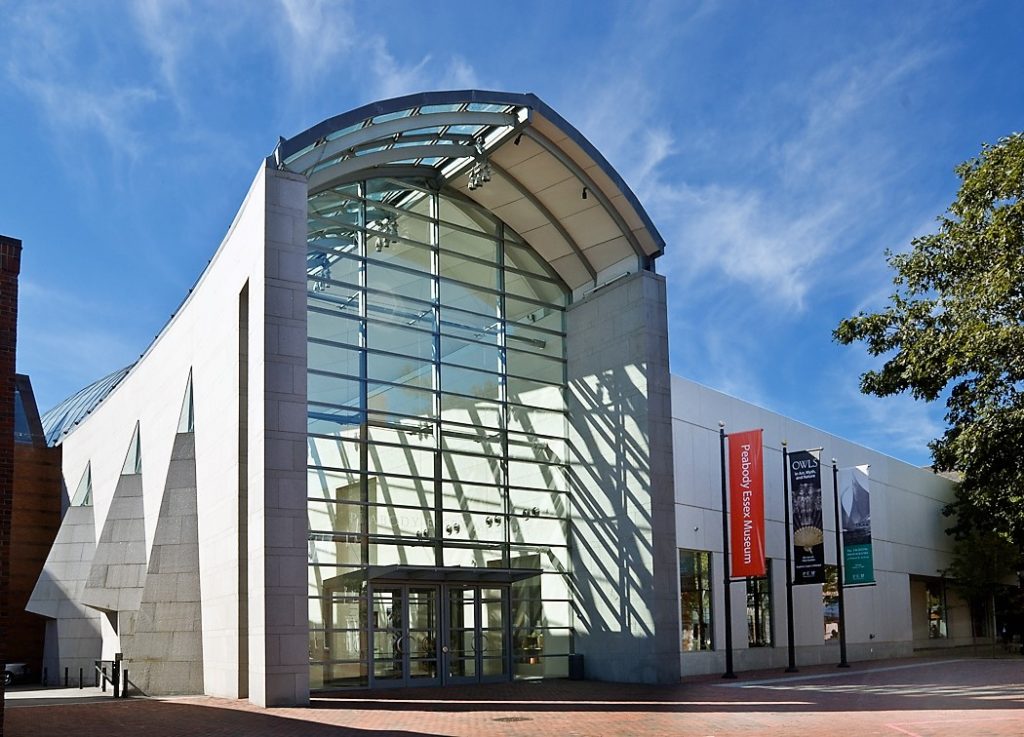
Entrance to the Peabody Essex Museum

Large Rodin “The Thinker” Statue
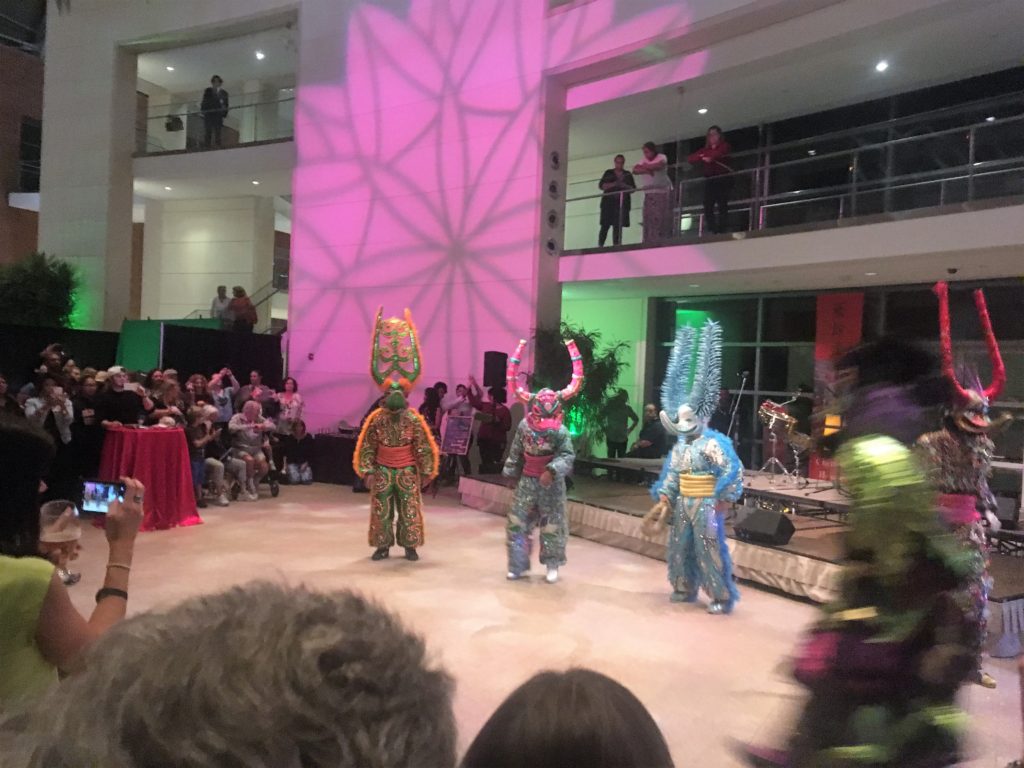
PEM/PM Dominican dancers!
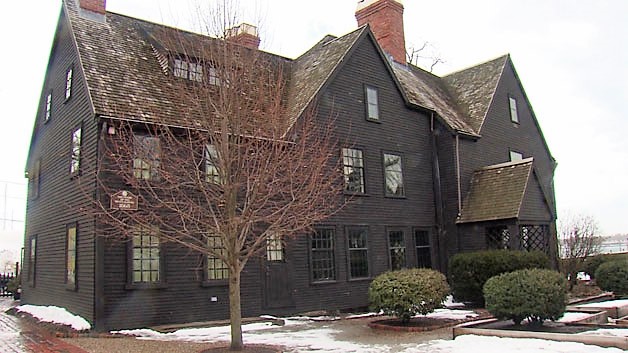
House of Seven Gables
Regardless of what you’re looking for, Salem is a great town to visit for a day or two near Boston!
Love this post? Save it to Pinterest for later!
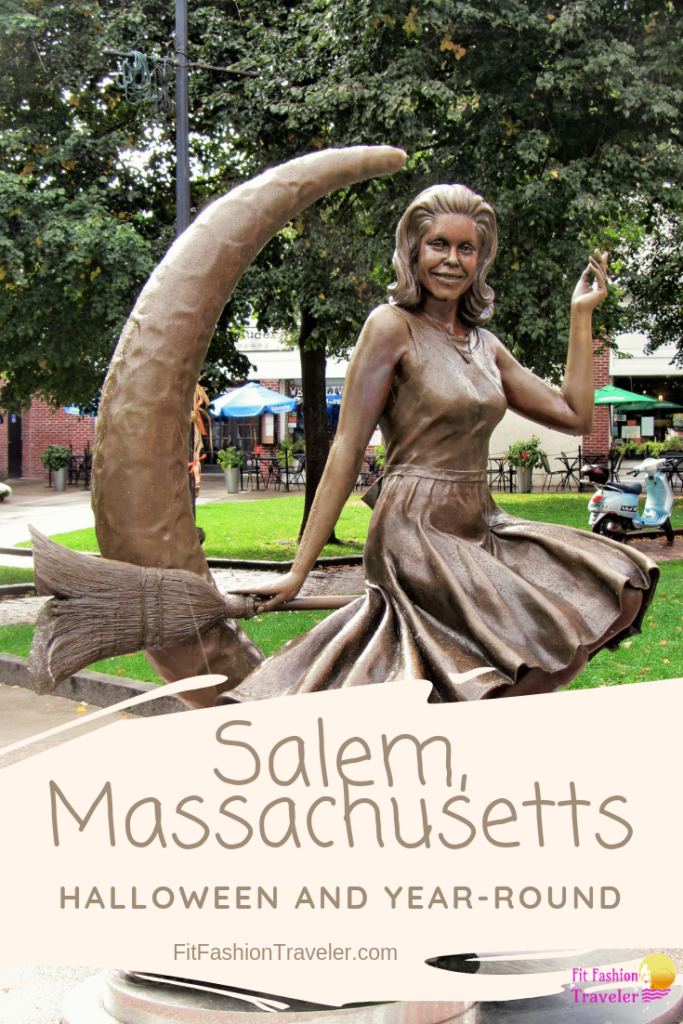

by Kelly | Feb 3, 2018 | Boston, Itineraries, Massachusetts, North America, Travel, United States
If you only have one day and want to truly experience everything Boston has to offer (or as much as you can in one day), here is a suggested itinerary.
8:00 AM: Breakfast
Start your day at Tatte (1003 Beacon Street, Brookline, MA: Green Line, C Line, St. Mary’s Street Stop), which is just over the city line in Brookline, MA. This European-style bakery has incredible pastries, lattes, and hot brunch options. In the summer months you can sit outside on the sidewalk to enjoy your breakfast, but thanks to a recent renovation there’s ample seating inside as well.
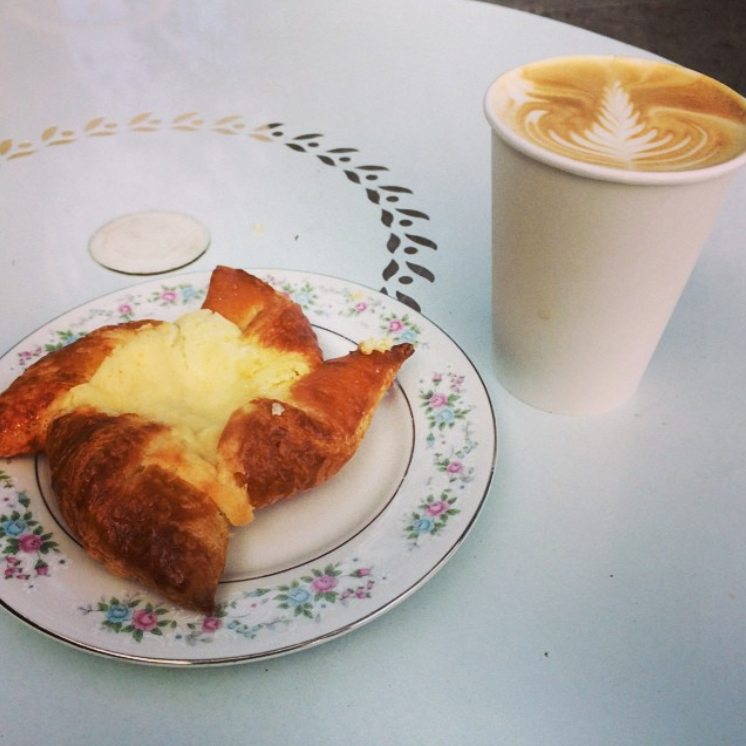
Latte and Pastry at Tatte
9:00 AM: Tour of Fenway Park
Once you’ve finished your breakfast, walk over to Fenway Park for their 9 AM guided tour of the park. The website recommends arriving 15 minutes early for this one-hour behind the scenes look at America’s oldest ballpark.
10:30 AM: Museum of Fine Arts
Next, walk through the Fens to the Museum of Fine Arts (“MFA”), where you can wander around for a couple of hours viewing either the historical artifacts of Ancient Egypt and Greece, or the more recent artwork from Europe, Asia, and the Americas. If there is a special exhibit, be sure to check it out, they are always worthwhile.
12:30 PM: Lunch Downtown
Take the Green Line, E Line, from the Northeastern T Stop to the Copley T Stop and head to Atlantic Fish on Boylston Street for lunch. Again, if it’s a nice day outside, ask for a table on the sidewalk and watch the busy Bostonians hustle by. If you’re not a fan of seafood, then your destination is Stephanie’s on Newbury, which again has highly-recommended outdoor seating and one of the best brunches in Boston.
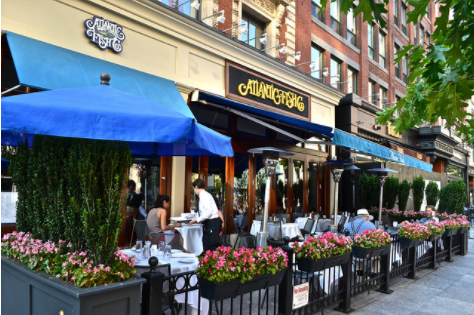
2:00 PM: Boston Garden/Freedom Trail
Spend the afternoon after lunch walking the Freedom Trail. I know in another post I recommended starting the trail at the end, at the USS Constitution, and ending at the Boston Garden, but today you’ll start in the Boston Garden, which is only a 15-minute walk away from lunch. Spend time leisurely wandering Boston exploring the first half of the Freedom Trail, from the Boston Common to the North End, where you’ll end for dinner. If you read a guidebook or Google historical sites you can follow a self-guided tour, or you can join an official 90-minute Walk into History tour led by actors in historical costumes. If you choose the 90 minute tour you will also have time for relaxing by the harbor front or finishing the Trail with the Bunker Hill Monument and USS Constitution before dinner.
5:00 PM: Dinner North End
Enjoy a long Italian dinner in the North End, the Italian section of Boston. Pick any restaurant you’d like, you can’t go wrong with anything in the area, especially on the main drag Hanover Street, Salem Street, or any side streets off of these roads. My favorites include Ristorante Fiore, La Famiglia Giorgio’s, and Nico.
8:00 PM: Boston Symphony Orchestra or Boston Pops Show
From the North End you can either hop back on the T, the Green Line, E Line, at the Haymarket Station and take the train all the way to the Symphony stop, or just grab an Uber to Boston Symphony Hall. Depending on who is playing that night you can either watch a performance by the Boston Symphony Orchestra or the Boston Pops. Many world-famous musicians come to play with the BSO such as Yo Yo Ma, and if you are in town during the holiday season, you don’t want to miss the Boston Pops’ Holiday performance!
10:00 PM: Drinks at Top of the Hub
End your night with a couple of cocktails at the Prudential Center’s Top of the Hub restaurant while enjoying the spectacular views of the city. If your day in Boston is a Saturday, you can enjoy the live jazz music while enjoying your drink and the view.

*Like what you see here? Contact me for your own customized travel itinerary!
Love this post? Save it to Pinterest for later!
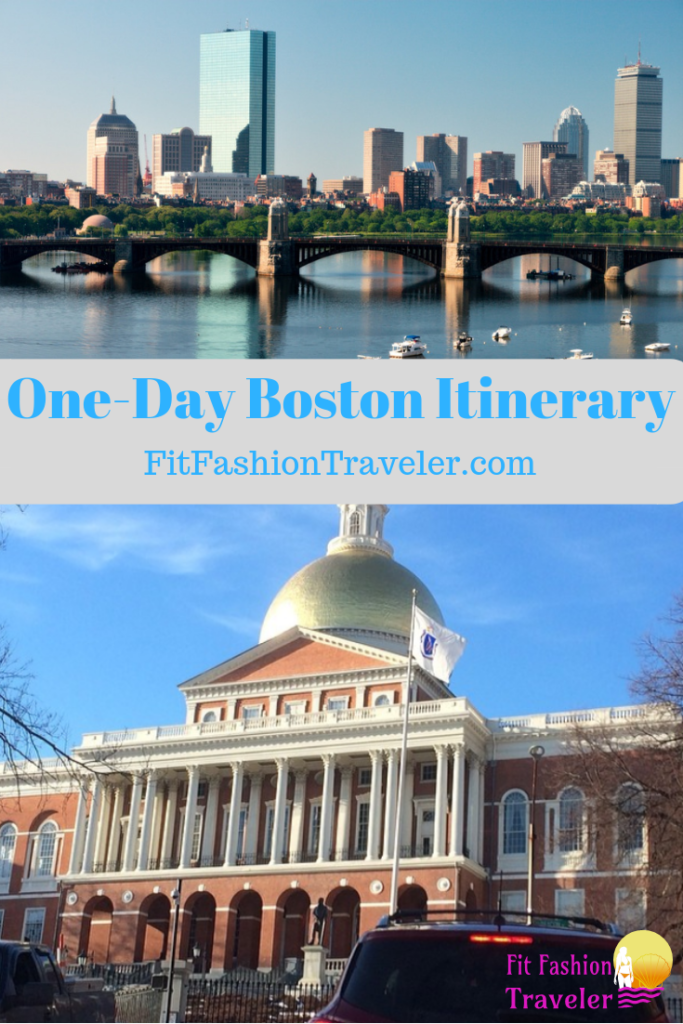
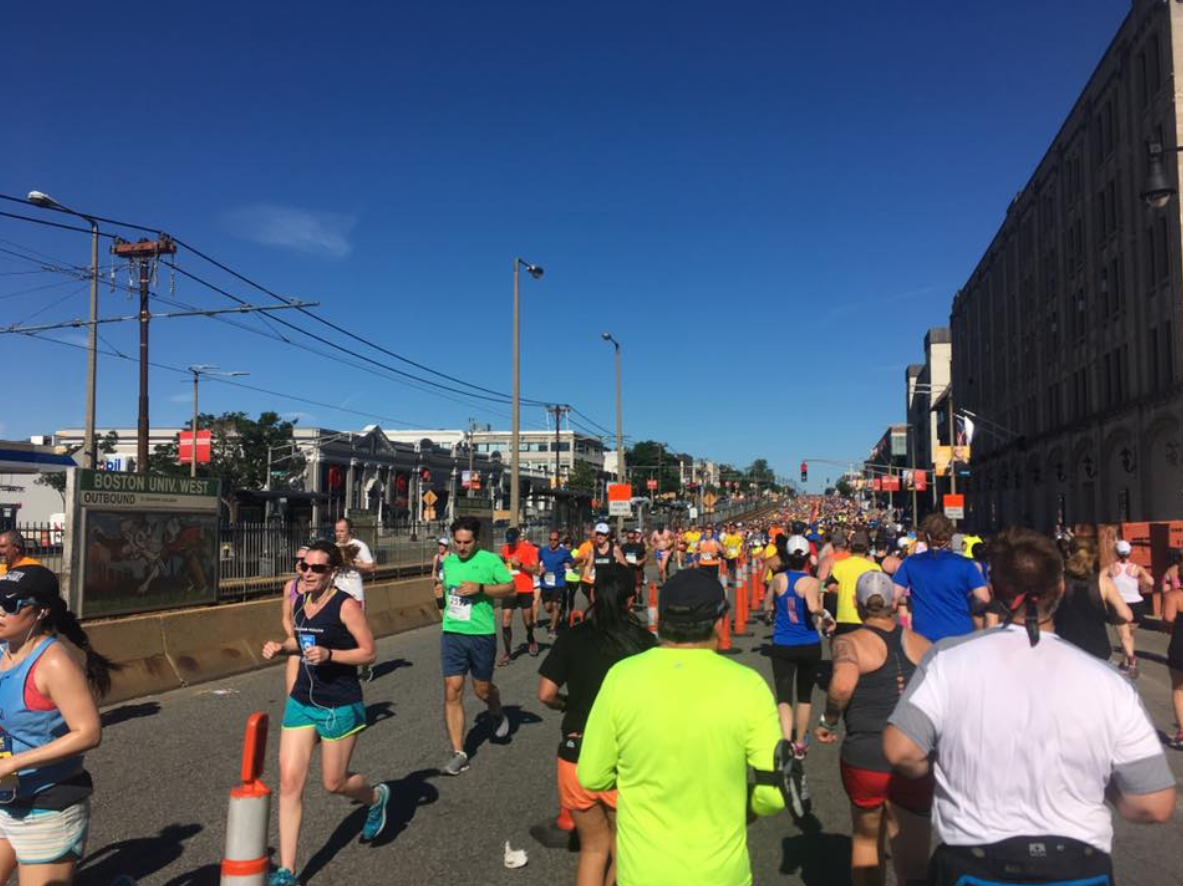
by Kelly | Jan 23, 2018 | Boston, Fit Travel, Massachusetts, North America, Travel, United States
There is no shortage of fitness options in this city! Boston is an epicenter of young professionals, and we certainly uphold the millennial stereotype of enjoying our studio classes and other workouts in the city.
Outdoor Options
Boston has many green spaces perfect for working out year-round. As the top running race in the world, the Boston Marathon, is held here, you will always see people who are either training for the Marathon or inspired by the runners running through the streets and on the Esplanade along the Charles River. If you are not at a level to participate in the Boston Marathon, the Boston Athletic Association offers 5K, 10K, and Half Marathon Races that run on the same streets through the city. In fact, the 5K occurs two days before the Marathon and the route has runners race right over the Marathon finish line after making the infamous right on Hereford, left on Boylston turns that marathon finishers make.
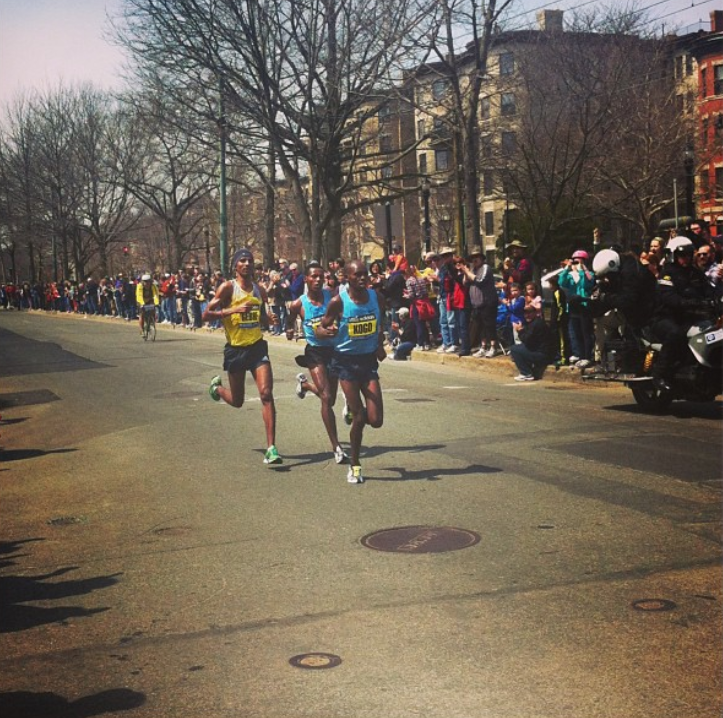
Boston Marathon Top Runners
Biking has also become popular in Boston recently. Many people use the city’s well-constructed bike lanes to commute to and from work, but if you’re looking for more of a leisurely ride you can rent a Hubway bike with a credit card from any of the Hubway stands and then ride along the Esplanade or the Charles River Bike Path in Cambridge with no risk of interference from motor vehicles.
Many fitness centers offer free outdoor classes in the summer as well. Through these programs you can find yoga in the parks, early morning outdoor boot camp classes, and Zumba® by Healthworks at the Hatch Shell on the Esplanade in the evening!
Spin Studios
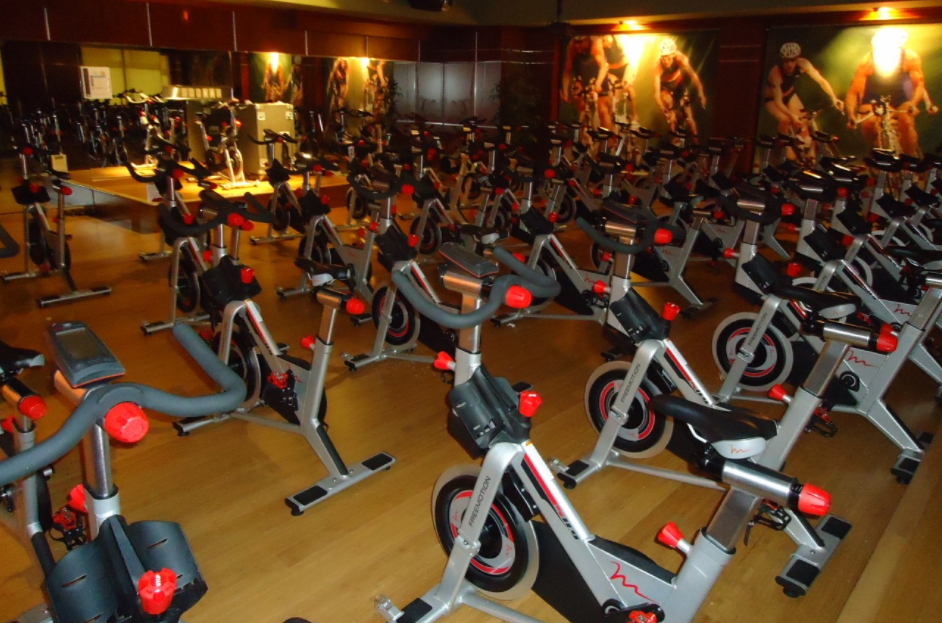
What city full of young professionals would be complete without a plethora of spin studios? In Boston, you will find the national studios Soul Cycle, Turnstyle, and Flywheel, as well as local studios including B Spoke, The Handle Bar, and C-Town Cycle. Most of these locations offer free or discounted classes for first-time students, so you can try as many as you’d like without spending your entire vacation budget! My favorite – so far – is Turnstyle’s South End studio, but I have friends who prefer B Spoke, Soul Cycle, and Flywheel as well.
Yoga Classes
As with the spin studios, Boston’s residents would not be content without yoga studios around every corner. There are really too many to list, with local studios seemingly appearing every week, but some of my favorites include Down Under Yoga and Core Power Yoga (especially the C2 class). I’ve never had a bad experience at a Boston yoga studio, and similar to the spin studios, most studios will offer first-time student discounts or free classes so you can check them out while you’re in the city.
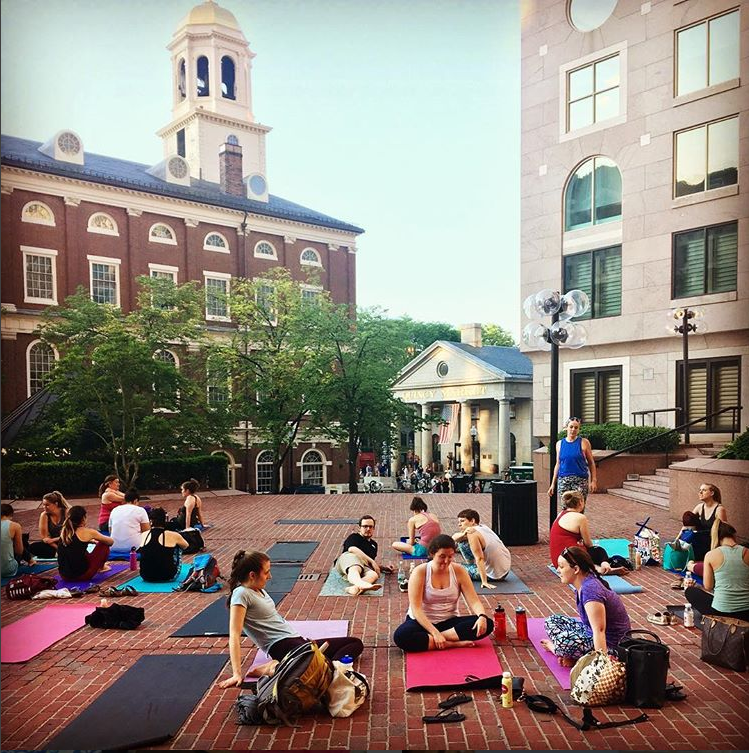
Yoga in the shadow of Boston’s Faneuil Hall
Indoor Rock Climbing
A recent phenomenon in the Boston area is indoor rock climbing. Brooklyn Boulders and Rock Spot Climbing are the two favorites among Bostonians. Just show up with your sneakers and the gyms will have all the other equipment that you need, like helmets and ropes. A professional on site will be available to explain everything and help belay if you’ve never done rock-climbing before, so if you are up for something new this is certainly worth trying out!
Dancing Lessons
A common theme you will come to notice in my posts is that I love to dance, and try to fit dancing into my life as much as possible. Because of this, I must talk about dancing in Boston as a fitness option. In addition to just sweating it out in one of our clubs or lounges on a weekend night, Boston offers dance lessons at various studios for those looking to learn the basics of different styles of dance.
The Boston Ballet, the company that produces The Nutcracker each year, offers open adult classes to which you can drop-in. If you’ve never danced before, the company provides an Intro to Ballet Workshop where you can start your journey towards becoming a ballerina. If you travel a bit outside the city, The Studio in Brookline also offers drop-in adult dance classes for all levels in many styles of dance including ballet, tap, jazz, lyrical, contemporary, and pointe.
To learn some Latin dancing, especially Caribbean-style salsa, check out the lessons offered by Salsa y Control in Allston and Cambridge. The instructors from Salsa y Control also offer lessons at The Havana Club in Cambridge on Friday nights before the club is open to all levels for the best Latin dance party in Boston, where you can show off the moves you learned!

Night Out at the Havana Club
Love this post? Save it on Pinterest for later!
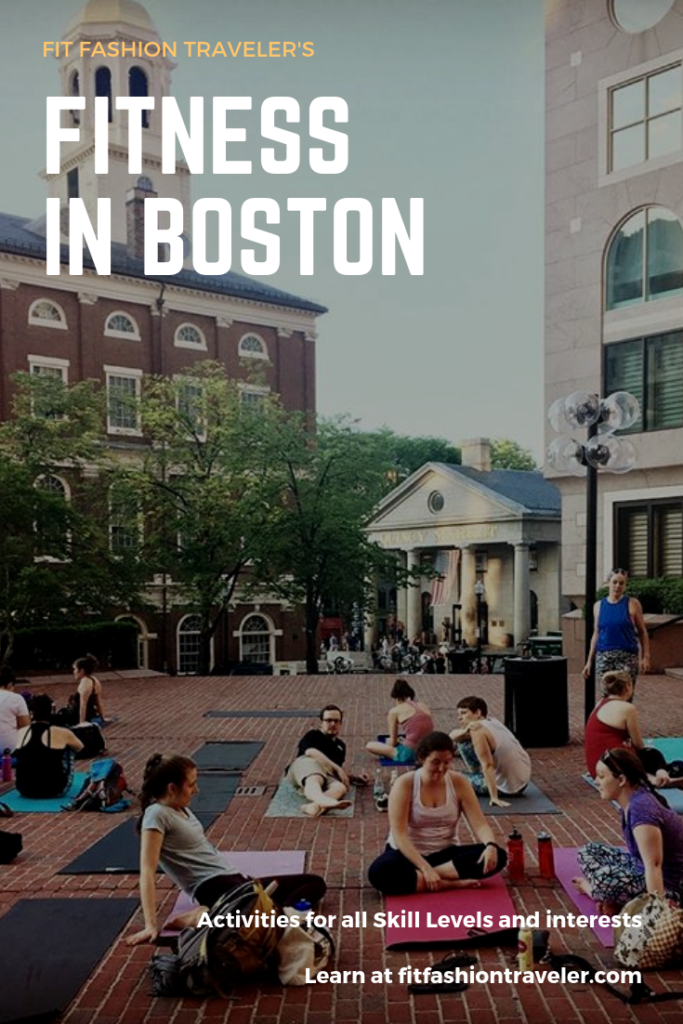
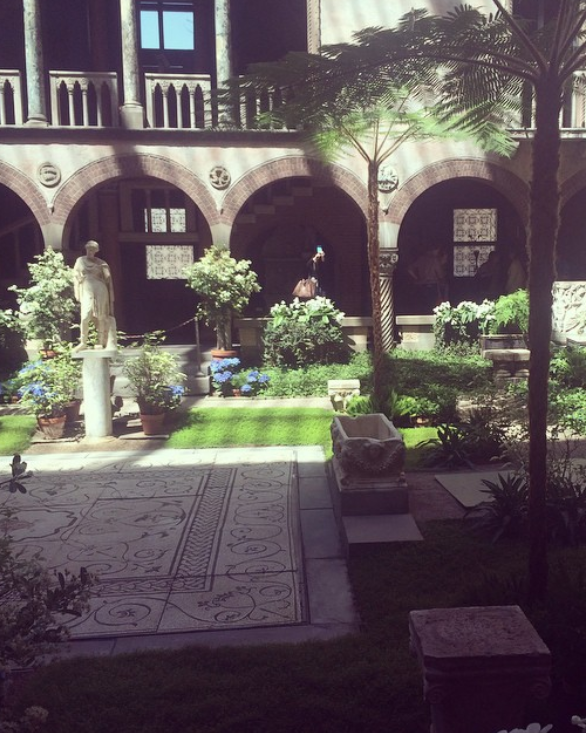
by Kelly | Jan 5, 2018 | Boston, Massachusetts, North America, Travel, United States
The other day a good friend asked for ideas of things to do in downtown Boston with his wife for their anniversary, and I completely blanked! To be fair, it was the middle of December and forecast to be the coldest day of the season so far with a high of 10 degrees Fahrenheit, so I was limited to activities that didn’t require being outside at all. Since that day, and in preparation for writing this entry, I’ve been thinking hard and talking with friends about what the top attractions are in Boston. I hope there’s something that appeals to everyone!
Go See a Game
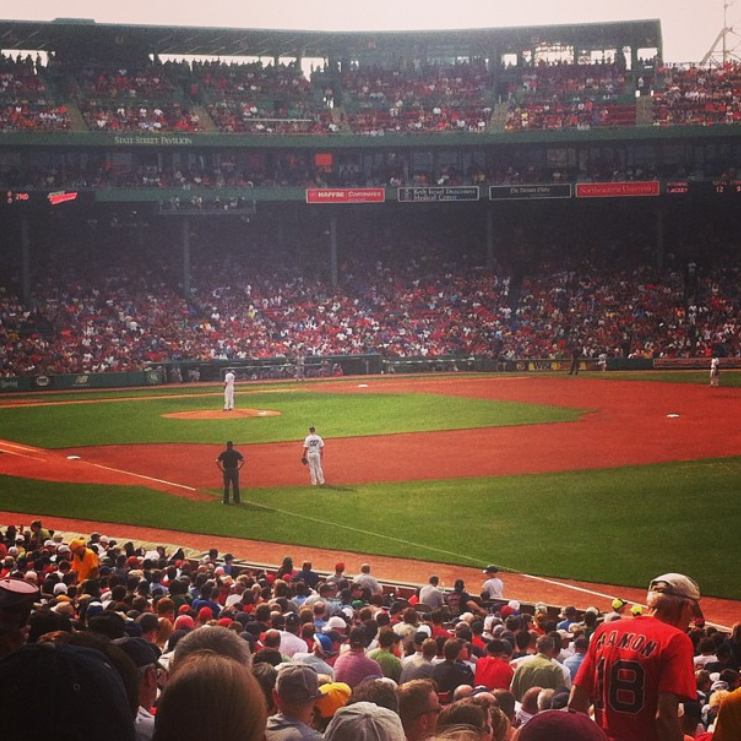
Red Sox – Yankees Game in the iconic Fenway Park
One of Boston’s many nicknames is the “City of Champions,” and with good reason: we have professional teams for all four of the major American sports (football, basketball, baseball, and hockey), and each has already won at least one national championship in the past 10 years. No matter which season you decide to visit Boston, you will be able to catch a game. If you want a relaxing, family-friendly atmosphere to both spend time with your friends and catch a game in America’s oldest ball field, check out the Red Sox at Fenway Park from April through September (or October if they make the playoffs!). If you want an intimate venue where you’re part of the action, head to TD Garden to watch either the Boston Bruins play hockey or the Boston Celtics in a basketball game: they share the venue, so be sure to check out which team is in town when you are in Boston. If you’re willing to make the trip – and pay the price for the tickets – you can catch a train or drive about 40 miles South of Boston to Foxboro to watch the five-time Super Bowl Champions the New England Patriots take on other football opponents on Thursdays, Sundays, or Mondays from August through January.
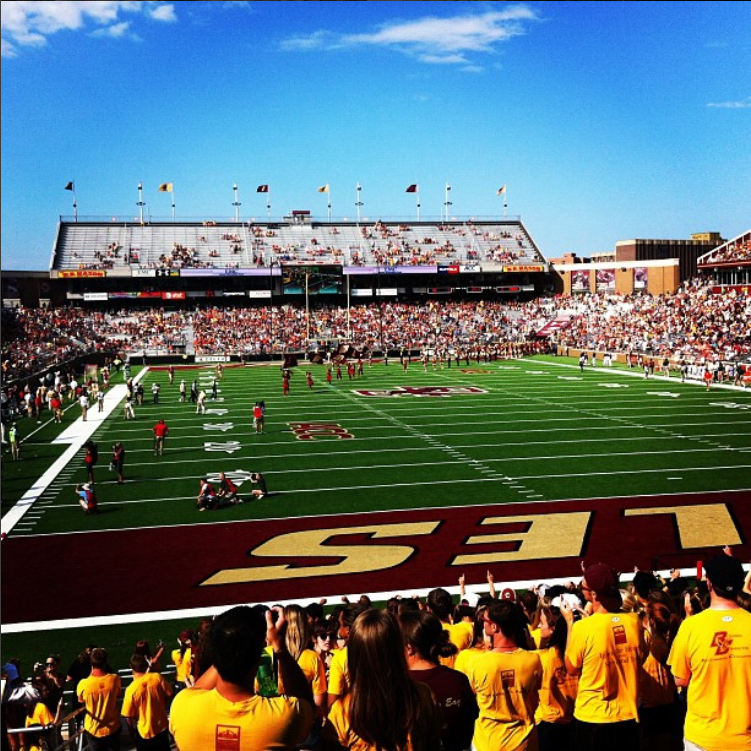 Finally, if quintessential American sports are not your thing, you could always catch a New England Revolution game (soccer), watch thousands of top runners from around the world compete in the Boston Marathon, which takes place the third Monday of April every year, or cheer on crew teams in the Head of the Charles the third weekend of October. College sports teams in the area, including Boston College, Boston University, Northeastern, and Harvard, are also exciting to check out, and usually for a fraction of the price of their professional counterparts!
Finally, if quintessential American sports are not your thing, you could always catch a New England Revolution game (soccer), watch thousands of top runners from around the world compete in the Boston Marathon, which takes place the third Monday of April every year, or cheer on crew teams in the Head of the Charles the third weekend of October. College sports teams in the area, including Boston College, Boston University, Northeastern, and Harvard, are also exciting to check out, and usually for a fraction of the price of their professional counterparts!
Check out Boston’s Museums
Boston is a world-class cultural center with many opportunities to see valuable works of art and experience scientific innovation at any of the museums around the city. I’ve listed some of my favorites with a brief description below.
Museum of Fine Art: Premier collection of world-renowned art from Ancient Egypt to modern America, including incredible temporary exhibits as well.

Isabella Stewart Gardner Museum: Site of the famous 1990 Rembrandt Heist, former mansion of Isabella Stewart Gardner filled with her personal collection of art she collected in her world travels during the 20th century.
Museum of Science: Contains not only typical science museum exhibits, but a great Planetarium and Omni experience theater. From March through November you can also head to the Observatory on Friday nights to check out the real night sky.
John F. Kennedy Library: The 35th American President was born in the Boston suburb of Brookline, where his house is still available for tours in the Spring and Summer months. His Presidential library sits on the South Shore of the city, accessible by public transit, and takes visitors through his youth, time serving in World War II, Presidential achievements, assassinations, and other contributions to the country by his family members.
New England Aquarium: While not technically a museum, this aquarium is great for aquatics-lovers to stop by with its multi-floor eco-system in the center, a touching-tank with sea rays and sharks, and the main attraction, penguins!
Mapararium: Take a tour inside this three-story glass globe built in the early 1900s, to see not only this impressive feat of architecture but also how the world has changed in the past century.
Many of Boston’s museums offer special monthly events as well with drinks, music, and programs geared towards adults, including the Museum of Fine Arts’ First Fridays, the Gardner Museum’s Third Thursdays, and Boston “Grown-Ups” Museum night at the Boston Children’s Museum.
Walk the Freedom Trail
Whenever I have family members visit me in Boston for the first time, they always ask about walking the Freedom Trail. While the trail is claimed to start in the Boston Common and end at the USS Constitution ship in Charleston, I would recommend going backwards and ending at the Common where there are plenty of locations to grab food or drink and relax when you have finished, including the original Cheers bar. There are 16 official stops on the Freedom Trail, which can all be found by following the Red Brick Line in the sidewalk (similar to Dorothy’s Yellow Brick Road in the Wizard of Oz). Here are the stops I find most interesting:
USS Constitution: From the late 1700s, this is the oldest commissioned warship still afloat. After surviving the War of 1812 fighting against the British troops, she was given the nickname “Old Ironsides.” You can buy tickets to go on board and take a tour while she is docked.
Bunker Hill Monument: The second stop on the trail going backwards, the monument has 294 steps to climb to the top for a unique view of Boston.
Old North Church: The oldest church still operating in Boston, the steeple of this church is where the lanterns were purported to have been hung, “one if by land, two if by sea,” to signal to Paul Revere how the British were approaching so he could set off on his midnight ride to alert the colonists.
Paul Revere House: Built in 1680 and purchased by Paul Revere in 1770, you can visit the house where Revere and his family lived during the Revolutionary War.
Faneuil Hall: Filled with cute shops and vendors on the first floor, the meeting room on the second floor is where our Revolutionary Leaders met during the war, and where the Sons of Liberty expressed dissent against Royal oppression. While here, you can also stop by the shops and eateries of Quincy Market.
Site of the Boston Massacre: Identified by just a plaque, you can stand on the exact spot where the British troops shot at the colonists to ignite the beginning of the American Revolutionary War. A reenactment to commemorate the event takes place every year on the site.
Old State House: Visit the Old State House for a fascinating museum about the Revolutionary War, then step outside to look at the golden lion statue sitting atop the roof: in 2014 a time capsule from 1901 with its contents in almost perfect condition was found in the lion’s head when it was taken down for restoration.
Granary Burying Ground: An incredible cemetery in the heart of Boston near the Common, including a giant monument with the name “Franklin” on it, under which Ben Franklin’s parents are buried. Other individuals of note buried in this cemetery include Sam Adams and John Hancock.
Massachusetts State House: Impossible to miss with its gilded dome, the Massachusetts State House was built in 1798 and is still used by State Senators, Representatives, and the Governor to conduct state politics. You can take a tour or just step in to look at the interior of the dome and artifacts around the rotunda.

Boston Common/Boston Gardens: The Freedom Trail begins, and in this case ends, at the Boston Common. Used for many public purposes, including witch hangings in the 1700s, today you can find many families and college students enjoying the sun in the Common in the warm months, and ice skating on Frog Pond in the cold months. Walk through the Common to the Boston Garden, where the Swan Boats continue to make their way around the Pond in the summer months after almost 150 years of operation.

Swan Boats in the Boston Garden Pond
Take in a Show
Seeing as it is currently the holiday season in Boston, I cannot imagine being in this city without catching one of the many shows available. Check out the schedule at the Boston Symphony to see whether the Boston Symphony Orchestra or Boston Pops are performing: if you are under 40 years old, you can get $20 tickets for select performances, and if you plan your trip to see the Boston Pops right, you could see John Williams himself conducting some of his hits from movie scores including Jaws, Jurassic Park, Star Wars, and Harry Potter! Many college music groups also provide cheap or free shows, including most Berklee organizations and the Boston College Symphonic Band, who performs at the Hatch Shell each summer.
If theatre is more your thing, you can check out Shakespeare in the Common during the summer months, or a hilarious version of Shakespeare with a drunk cast member not quite following the script in Sh*tfaced Shakespeare. Again, many colleges will also put on their own theatrical productions throughout the year.
You may instead choose to see the Boston Ballet (their version of the Nutcracker is amazing), a Broadway in Boston show, or check out a comedy performance at the Improv Asylum. Many top-billing performers also come through the city frequently, performing not only at big venues like TD Garden but also more intimate music venues like the Royale, House of Blues, and Paradise Rock Club.
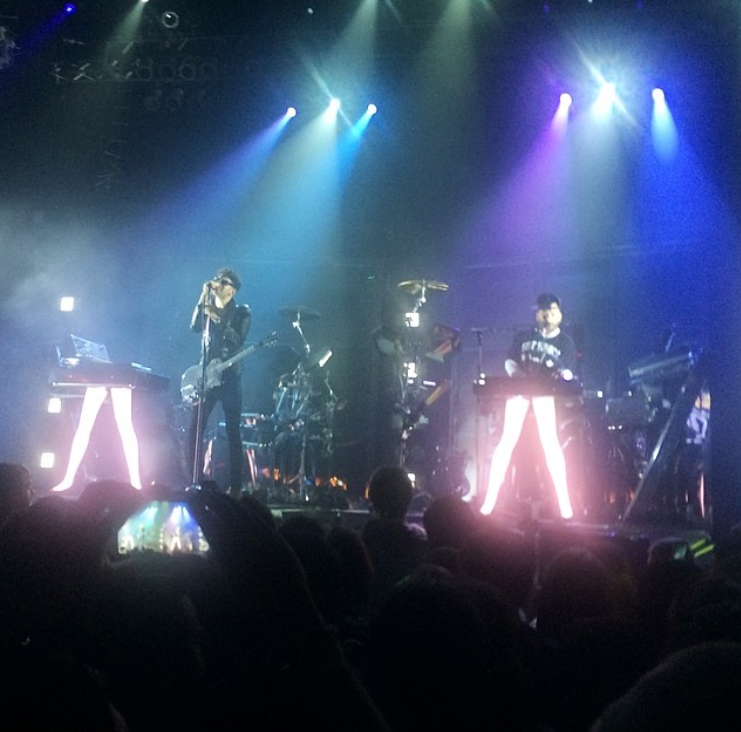
Chromeo performing at the House of Blues
Of course, as in any city, you could also fill your days wandering the streets of Back Bay, Downtown, South Boston, and the North End, going on college visits to view the campuses of Harvard, MIT, Tufts, and Boston College, and sit by the water in the Seaport or at the beach, but I wanted to provide examples of some of the unique cultural experiences Boston also has to offer.
Love this post? Save it on Pinterest for later!


by Kelly | Mar 25, 2017 | Boston, Massachusetts, North America, Travel, United States
Boston has a plethora of restaurants, bars, lounges, and places to dance and experience the nightlife! As this blog is meant to focus on high-end locales, I will highlight some of my favorite luxury restaurants, bars, and clubs. If you’d like additional information on any of the places discussed, or suggestions for less-high-end locations, please feel free to contact me!
Restaurants
-
Eastern Standard
The Eastern Standard provides your typical upscale American fare with a European ambiance. It is also just a couple of blocks from Fenway Park, making it a great place to go before or after a Red Sox game. They have amazing oysters sourced from the Southern Coast of Massachusetts due to their affiliation with their neighboring restaurant Island Creek Oysters (also highly recommended). This is also a hot spot for brunch with a fantastic Eggs Benedict and House Smoked Salmon. The rest of the menu, including the cocktail menu, rotates on a seasonal basis, but I’ve gone here for years and have never been disappointed. If you enjoy the hustle and bustle of the city, you can sit on Eastern Standard’s sidewalk patio in the heart of Kenmore Square in the warmer months, allowing you to enjoy the warm weather while engaging in some fantastic people-watching.
-
Smith & Wollensky at the Castle
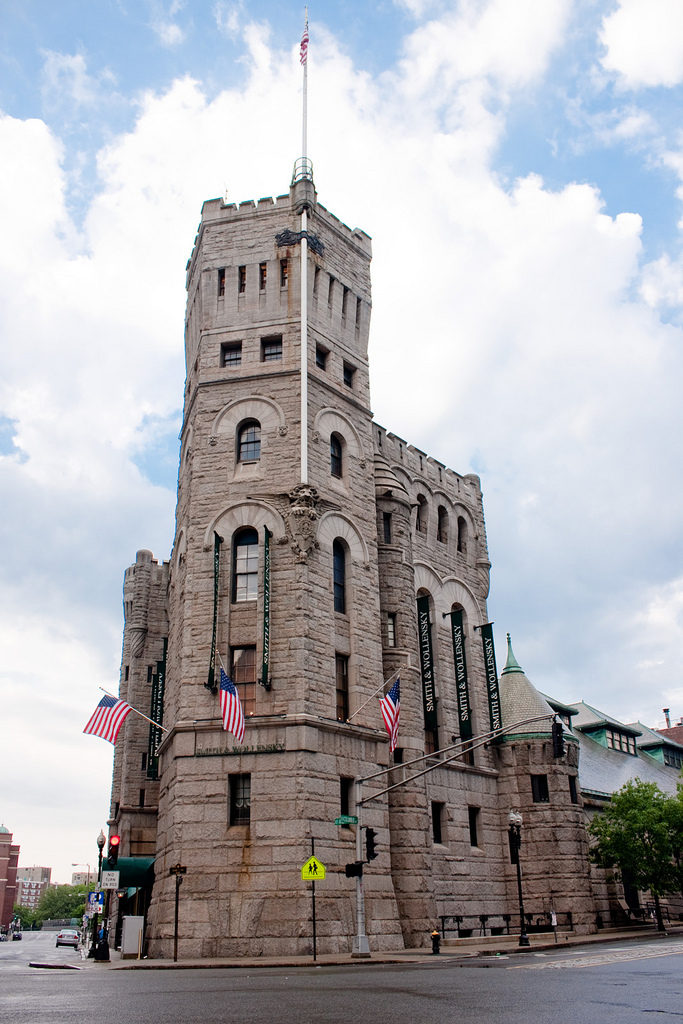 At the end of the 19th Century, Massachusetts built a Victorian Armory for its First Corps of Cadets. It was one of many armories in Boston at the time, but is now the last standing Victorian Armory in Boston and home to Smith and Wollensky , one of Boston’s premier steakhouses. When you arrive at The Castle, as the Armory is now called, you are greeted by the friendliest, most helpful staff, who bring you to your table in one of the many available rooms. There is certainly an air of elegance throughout the entire restaurant, though it is coupled with well-placed armory memorabilia. On top of the atmosphere, the food is incredible: the steaks, especially the filet mignon, are carefully selected and cooked perfectly. One of my favorite side dishes is the Truffled Macaroni & Cheese: if you can’t make it to Smith & Wollensky in the near future, their Macaroni & Cheese recipe is available online (I made this for my family one year for Easter and it was a big hit)!
At the end of the 19th Century, Massachusetts built a Victorian Armory for its First Corps of Cadets. It was one of many armories in Boston at the time, but is now the last standing Victorian Armory in Boston and home to Smith and Wollensky , one of Boston’s premier steakhouses. When you arrive at The Castle, as the Armory is now called, you are greeted by the friendliest, most helpful staff, who bring you to your table in one of the many available rooms. There is certainly an air of elegance throughout the entire restaurant, though it is coupled with well-placed armory memorabilia. On top of the atmosphere, the food is incredible: the steaks, especially the filet mignon, are carefully selected and cooked perfectly. One of my favorite side dishes is the Truffled Macaroni & Cheese: if you can’t make it to Smith & Wollensky in the near future, their Macaroni & Cheese recipe is available online (I made this for my family one year for Easter and it was a big hit)!
(Update June 23, 2018: Smith and Wollensky recently announced they will be closing their Castle location in Boston: locations are still open downtown on Atlantic Wharf and a new location is coming soon to Wellesley, MA)
-
Babbo
Babbo is an up-and-coming Italian restaurant in Boston’s up-and-coming Seaport district. A Mario Batali restaurant, Babbo brings a modern feel to classic Italian dishes. Last time I was there I ordered the Polpette Alla Griglia (Octopus on the Grill) and also tried the traditional Pizza Margherita. The octopus was a little spicier than I had expected, but still enjoyable and well-cooked. The pizza was relatively authentic compared to what I’ve eaten in Northern Italy, with a slightly thicker crust than the original Pizza Napoli. I also ordered the Sardinian Iced Tea, a mixture of prosecco, lime juice, and meletti amaro (an Italian liqueur), and it did not disappoint. For the wine drinkers, Babbo has an extensive list of Italian wines, all of which are fantastic. If you’re looking for something fresh yet classy in Boston’s hottest new district, Babbo is the way to go. One word of caution: as the Seaport is still being developed, parking can be a bit of a challenge, so if you are able to take the T instead, you can get off at Courthouse on the Silver Line, the closest stop, or take the Red Line to South Station and walk just over the water to Babbo.
Runner-Up Restaurants: Pier 6, Ristorante Fiore, Ruth Chris
Lounges
-
Top of the Hub
No post about Boston’s food and drink scene would be complete without discussing the Top of the Hub, Boston’s sky-high, 360 degree-view restaurant and bar on the 52nd floor of the Prudential Center. Many Bostonians have mixed feelings about the Top of the Hub, and I’ve heard it’s meals are overpriced for mediocre food (I have never come for an entire lunch or dinner). However, its drinks are amazing – both the classics and specialty house cocktails – as well as its desserts. During the day you can enjoy your drink with one of the best views of the city in a very relaxed atmosphere, high above the aforementioned hustle and bustle. In the evening things get a bit more lively: one of my favorite things to do on a Saturday night is to sit in the lounge at the Top of the Hub, enjoying the live jazz music and watching couples try to showcase their skills on the dance floor.

Here I am at the Top of the Hub enjoying a chocolate lava cake birthday dessert and a caramel apple martini while looking out on Boston
-
RumBa
Named for its extensive selection of rums from around the world, along with the Bostonian pronunciation of “bar” (hence Rum-Ba(r)), the InterContinental’s RumBa is one of my favorite cocktail bars in Boston. While my friends and I are easily the youngest people by decades when we go here, grabbing drinks at RumBa surrounded by accomplished business professionals makes us feel suave and sophisticated. This is a great place to come either after attending an event in downtown Boston or on a weekend afternoon in the summer when you can sit on the deck by the water. Their collection of liquors is extensive. I almost always order one of the rum cocktails with Mount Gay rum, which takes me back to my days on the beach in Barbados enjoying local rum punches.
-
Legal Harborside
Boston has a large selection of rooftop bars that open in April and remain open through the Fall. A few even opened for a couple days this past February when we had a week with temperatures in the 60s! Every year one of my friends and I obtain a list of all the rooftop bars in Boston and vow to get to each of them during the summer, and while every year we fail, Legal Harborside is one rooftop bar we have made it to multiple times. Not only does this place have killer sangria, but it also offers small plates including some pretty intense, delicious sushi. Sitting over the water in the Seaport, Legal Harborside has a retractable roof, high top tables with a city view, and large white lounge couches, if you can snag one. This is also one of the hottest after-work and weekend places to gather, and if you don’t arrive early enough you’ll encounter a fairly long line waiting to go upstairs to the third-floor roof deck.
Runners-Up Lounges: City Bar at The Lenox, Lolita, Audobon, The Charlesmark Lounge & Bar
Nightclubs
-
Icon/Venu/Cure
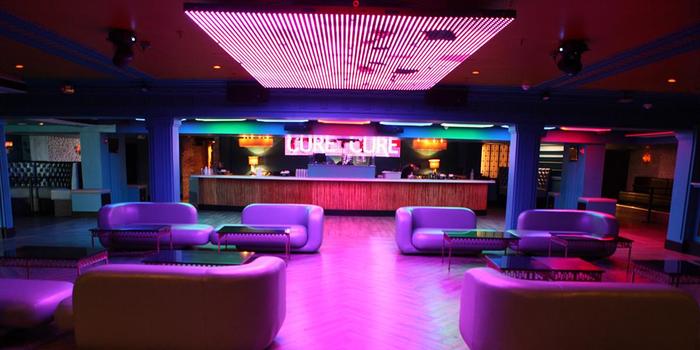 Space Entertainment throws some amazing dance parties at their clubs. The current lineup includes Cure on Thursdays, Venu on Fridays, Icon on Saturdays, and Cure again on Sundays. Cure is located under the Wilbur Theater – no, those people in line are not waiting to see a show, as I thought when I first went here – and has the most lounge-like feel of the three venues. It has many couches set up around and throughout the dance floor, though there is still plenty of space for dancing. However, don’t plan on using the couches unless you buy a table or make friends with someone who bought a table. Venu has a larger dance floor space in the middle of the club but much less personality than Cure: it is clearly meant for dancing. Icon (formerly Rumor) has two rooms with dance floors that include stages and VIP sections. Icon’s back room hosts Latin Nights on Saturday nights, but to control the crowds you need to either buy a table in the Latin Room or obtain a wristband from one of the club’s promoters. Because these are the only ways to access Icon’s Latin Room, the tables sell out quickly and it is very difficult to get a promoter to give up a coveted wrist band, let alone multiple wristbands for your crew. The difficulty with getting into the Latin Room is one of the reasons I prefer Cure Thursdays: Cure also boasts a back Latin Room, but movement between the main room and the Latin Room is fluid as long as there is space, no wristbands or tables needed. Regardless, you can’t go wrong with any of these locations if you are looking to dance and rub shoulders with some of the who’s-who of Boston: visiting sports teams and big name sports stars have been known to make appearances at each of these clubs.
Space Entertainment throws some amazing dance parties at their clubs. The current lineup includes Cure on Thursdays, Venu on Fridays, Icon on Saturdays, and Cure again on Sundays. Cure is located under the Wilbur Theater – no, those people in line are not waiting to see a show, as I thought when I first went here – and has the most lounge-like feel of the three venues. It has many couches set up around and throughout the dance floor, though there is still plenty of space for dancing. However, don’t plan on using the couches unless you buy a table or make friends with someone who bought a table. Venu has a larger dance floor space in the middle of the club but much less personality than Cure: it is clearly meant for dancing. Icon (formerly Rumor) has two rooms with dance floors that include stages and VIP sections. Icon’s back room hosts Latin Nights on Saturday nights, but to control the crowds you need to either buy a table in the Latin Room or obtain a wristband from one of the club’s promoters. Because these are the only ways to access Icon’s Latin Room, the tables sell out quickly and it is very difficult to get a promoter to give up a coveted wrist band, let alone multiple wristbands for your crew. The difficulty with getting into the Latin Room is one of the reasons I prefer Cure Thursdays: Cure also boasts a back Latin Room, but movement between the main room and the Latin Room is fluid as long as there is space, no wristbands or tables needed. Regardless, you can’t go wrong with any of these locations if you are looking to dance and rub shoulders with some of the who’s-who of Boston: visiting sports teams and big name sports stars have been known to make appearances at each of these clubs.
-
Bell in Hand
Bell in Hand is America’s oldest continuously operating tavern. It was where the Sons of Liberty, including Paul Revere and Sam Adams, gathered to plan the American Revolution in the 1700s, and the notorious Whitey Bulger met with his cronies in the 1970s. Today it is frequented by students and young professionals as a great place to grab a drink and dance to either the live cover bands on the first floor or top-40 music played by a DJ on the second floor. Entrance into the bar itself can include a wait that is well worth it, with another line awaiting you inside to reach the second floor. Both floors offer great nights of dancing depending on what you’re looking for: while the second floor has a more club-like atmosphere, don’t feel that you are missing out if you decide to forego the second line to enjoy the first floor’s band.
-
Alibi
You won’t find as many students at Alibi as the other clubs: this locale tends to attract successful young professionals in their late-20s and early-30s. Located in The Liberty hotel, you usually won’t have to wait in line as long to get in here as some other clubs, and cover and tables are a bit cheaper, though there is less of a designated dance space. Instead, people just dance with their friends throughout the bar. If you are going out with people for whom dancing is not their thing, one of the nice things about the Alibi is that while some of you are dancing in the lounge, others can enjoy The Liberty’s calmer drinking areas Clink and The Liberty Bar.
Runner-Up Nightclubs: Umbria Prime, Scholars, The Brahmin
Love this post? Save it on Pinterest for later!
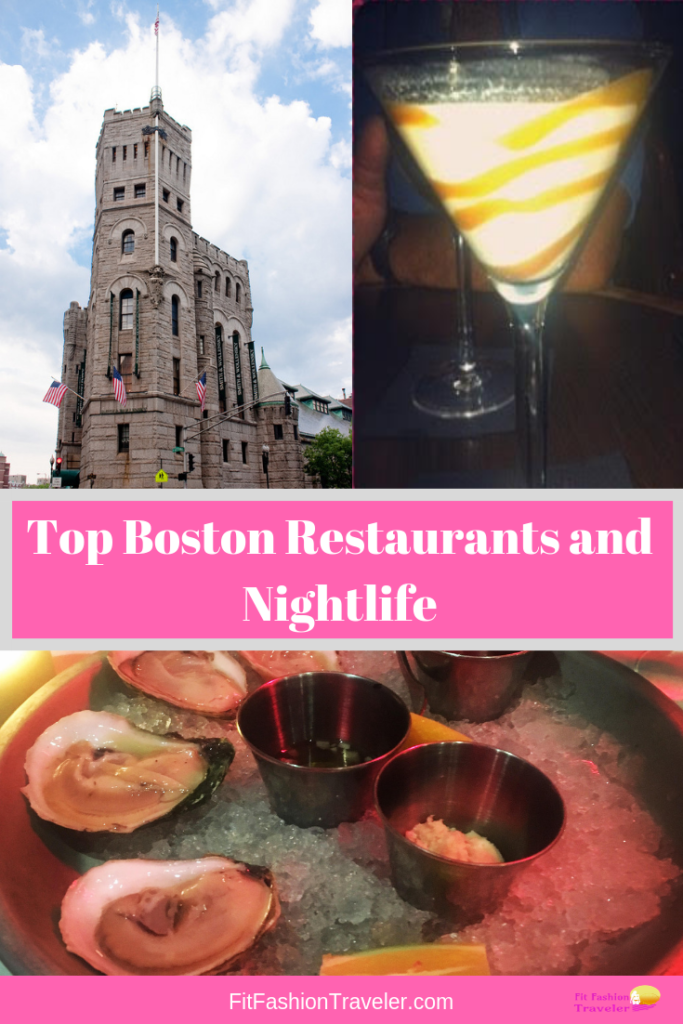
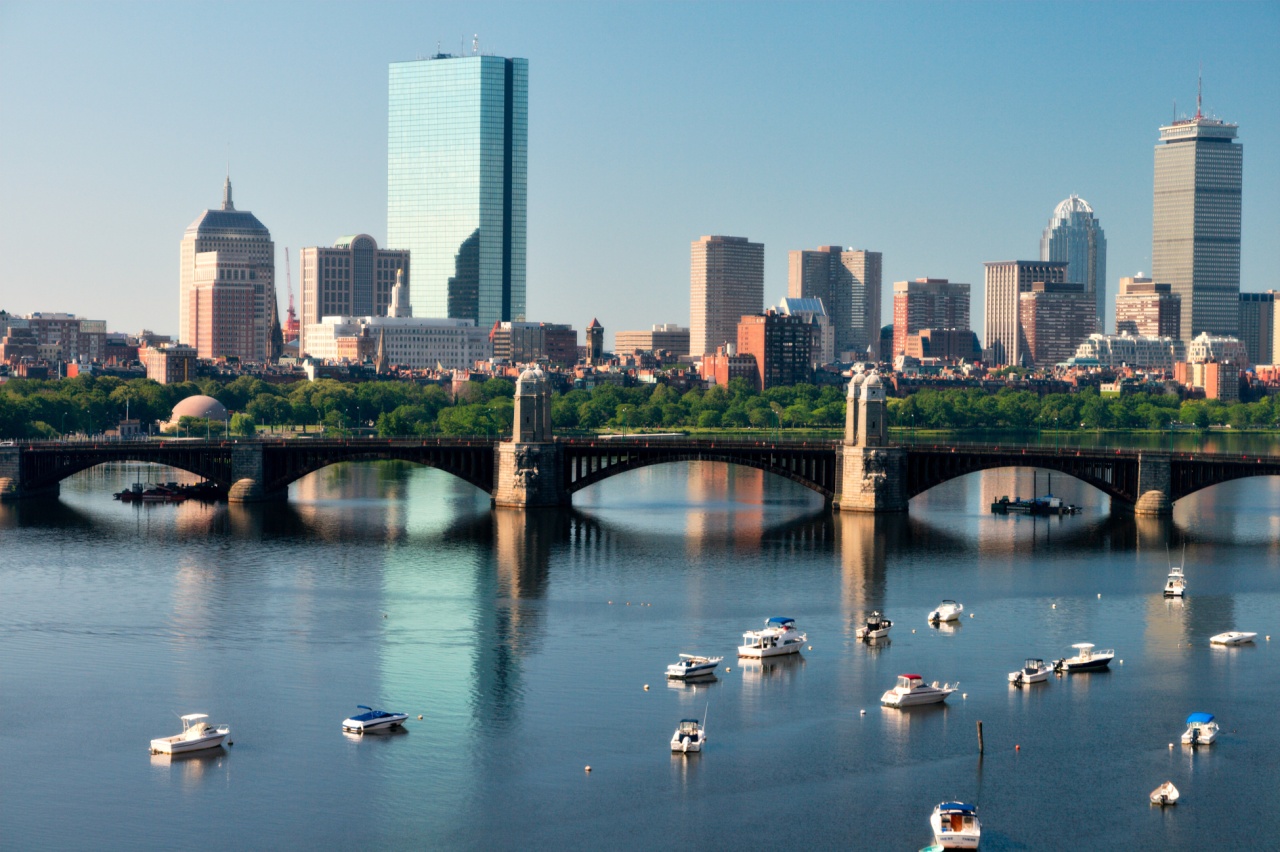
by Kelly | Mar 16, 2017 | Boston, Massachusetts, North America, Travel, Travel Advice, United States
So you want to visit Boston!
I have lived in Boston for about 10 years, first as a student and now as a young professional, and I am so excited to share what I know about the city over the next few posts. The first thing you need to do is get here: Boston is easily accessible by car, plane, train, and bus.
Driving to Boston
Boston is on the far Eastern coast of the United States. If you’re going to drive here, you have a few major highways to pick from. Visitors from the West, you’re probably going to drive in on Route 90 aka the Mass Pike or the Pike. I use the Pike every time I go home to visit my family and in 10 years I have never had a great experience. The speed limit may be posted as your standard 65 m.p.h., but if you’re not going at least 70 in the middle lane you will have someone on your bumper almost immediately. Further, the left lane is not necessarily used for passing, but for drivers going over 80 m.p.h. I recommend spending as little time on the Pike as possible, though it is unfortunately the best way for most drivers to reach Boston.
The other major highways running through Boston are Routes 93 and 95, both running North to South. In fact, Route 95 runs the entire length of the U.S. East Coast from Maine to Florida! They are more manageable to drive on than the Pike , but be careful going South on 93 as it doesn’t continue down to Rhode Island or Cape Cod (aka “the Cape”) but instead loops back around to the city.
As in any major city, parking in Boston can be difficult to find and expensive. If you are able to find a metered spot, I recommend using the “Park Boston” app to pay for your meter. If you find yourself out longer than anticipated and your meter is about to run out, you can just re-load time using your smartphone instead of running back to your car. If you are heading for the North End, the best garage to use is Parcel 7 because most North End locations will validate your ticket, leaving you to pay just $1 for 2 hours or $2 for 3 hours, which is unheard of in Boston. Most hotels will have parking garages available for you to leave your car, but likely at a steep price. Many people will opt instead to leave their cars outside the city at a T-station and take the T (the metro system) into the city instead.
Flying to Boston
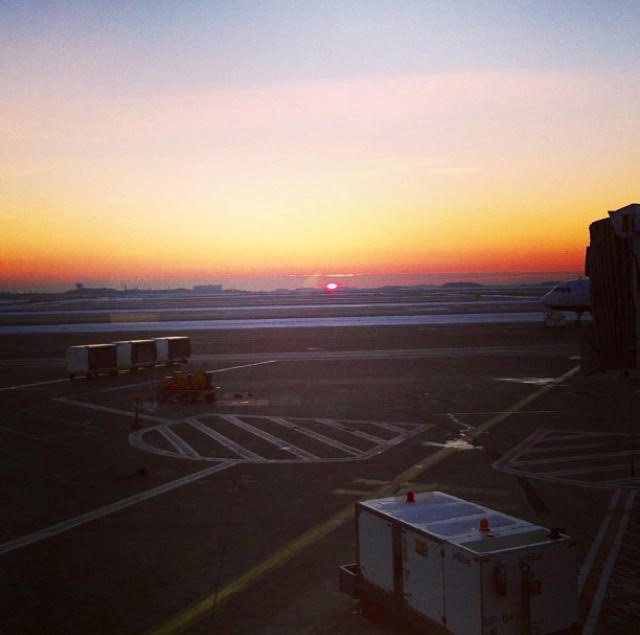
Sunrise over Boston Harbor from the window of Boston’s Logan Airport
Boston has its own airport pretty close to the city, Boston Logan Airport (BOS). This is the best airport to use to get to Boston, and it is serviced by 40 different airlines flying to and from 35 different countries and territories as well as most of the U.S. Other regional airports include Manchester, New Hampshire, and Providence, Rhode Island, but they are smaller, about an hour away, and will require you to rent a car or take a bus or train into the city.
Once you arrive at Logan Airport, you can catch a taxi at the taxi stand. The ride to city center will be about 15-20 minutes depending on traffic and cost about $35 plus tip. You can also rent a car, though as a local I have never had that experience so unfortunately cannot offer any information on doing so.
Your other option to get into the city is to take our metro system, known as the T! I highly recommend taking the Silver Line (which is actually a bus) to South Station, and then connecting to the rest of the T system from there. This is probably the quickest and most direct way to get to the city, and will take about 20 minutes. The other T line accessing the airport is the Blue Line: to use this line, you’ll need to catch the #88 shuttle bus at the airport, and then transfer at the aptly-named Airport T stop. Either way you choose, it will cost $2.75 per ride with a Charlie ticket, $12 for a 24-hour pass, or $21.25 for a 7-day pass. If you can find a Charlie Card at the airport, rides will be just $2.25 each.
Boston by Train or Bus
As with most cities, the most direct way to the city center is to arrive at the train station. Boston’s South Station is the main Boston station for Amtrak trains, though some trains also arrive at the North Station. The bus terminal is also located at South Station. Two types of trains roll into Boston each day, the Accela and the Northeast Regional. The Accela is more expensive, but travels faster and has less stops. Its interior is also more spacious and it usually has a dining car. The Northeast Regional is cheaper but stops multiple times along the Connecticut coast, in Rhode Island, and in southern Massachusetts coming from New York City (which could be ideal if you’re not originating in NYC).
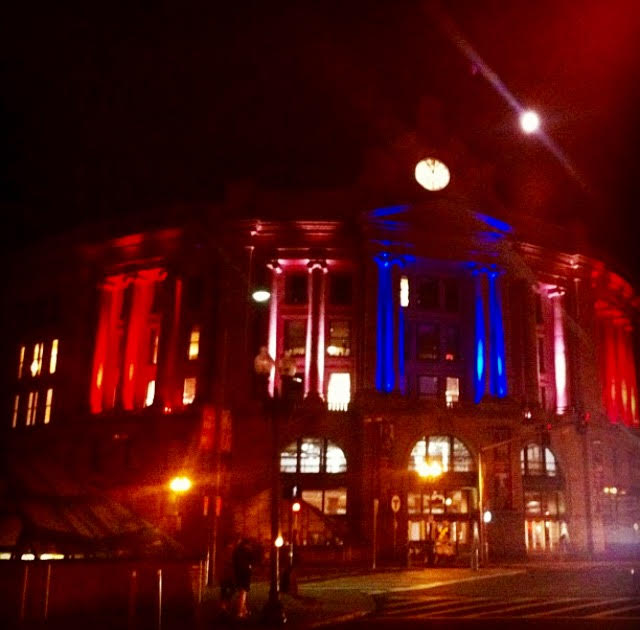
South Station by Night
You can take a bus to Boston from New York City, Springfield, MA, Rhode Island, New Hampshire, or Connecticut. Your bus line options run the gamut from the super-cheap Lucky Star and Mega Bus lines to the very common Peter Pan and Greyhound buses.
Both the Red and Silver lines of the T run through South Station, so as soon as you arrive you can easily get to your final destination! There is also a taxi stand available just outside where you can catch a cab.
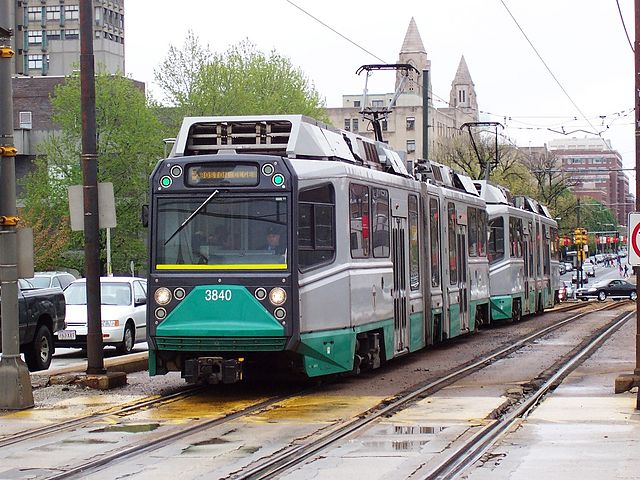
The T
Welcome to Boston! Now that you’re in the city, stay tuned for posts in the near future highlighting places to go and things to see.
Love this post? Save it on Pinterest for later!
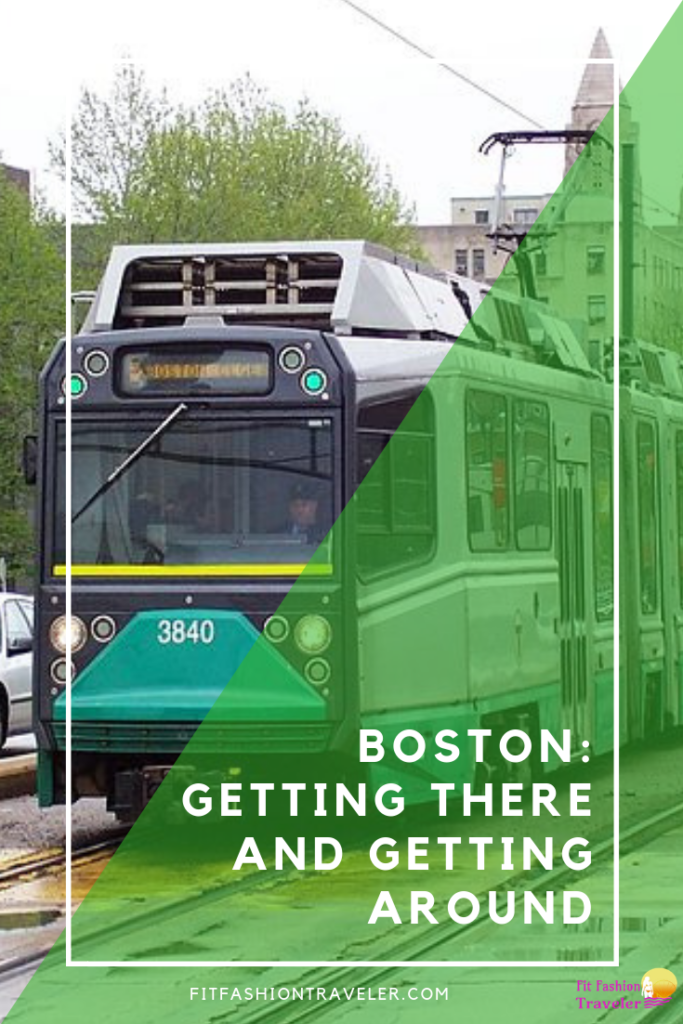












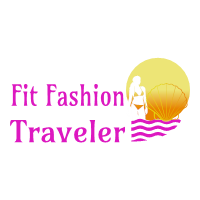

























































 Finally, if quintessential American sports are not your thing, you could always catch a New England Revolution game (soccer), watch thousands of top runners from around the world compete in the Boston Marathon, which takes place the third Monday of April every year, or cheer on crew teams in the Head of the Charles the third weekend of October. College sports teams in the area, including Boston College, Boston University, Northeastern, and Harvard, are also exciting to check out, and usually for a fraction of the price of their professional counterparts!
Finally, if quintessential American sports are not your thing, you could always catch a New England Revolution game (soccer), watch thousands of top runners from around the world compete in the Boston Marathon, which takes place the third Monday of April every year, or cheer on crew teams in the Head of the Charles the third weekend of October. College sports teams in the area, including Boston College, Boston University, Northeastern, and Harvard, are also exciting to check out, and usually for a fraction of the price of their professional counterparts!





 At the end of the 19th Century, Massachusetts built a Victorian Armory for its First Corps of Cadets. It was one of many armories in Boston at the time, but is now the last standing Victorian Armory in Boston and home to Smith and Wollensky , one of Boston’s premier steakhouses. When you arrive at The Castle, as the Armory is now called, you are greeted by the friendliest, most helpful staff, who bring you to your table in one of the many available rooms. There is certainly an air of elegance throughout the entire restaurant, though it is coupled with well-placed armory memorabilia. On top of the atmosphere, the food is incredible: the steaks, especially the filet mignon, are carefully selected and cooked perfectly. One of my favorite side dishes is the Truffled Macaroni & Cheese: if you can’t make it to Smith & Wollensky in the near future, their Macaroni & Cheese recipe is
At the end of the 19th Century, Massachusetts built a Victorian Armory for its First Corps of Cadets. It was one of many armories in Boston at the time, but is now the last standing Victorian Armory in Boston and home to Smith and Wollensky , one of Boston’s premier steakhouses. When you arrive at The Castle, as the Armory is now called, you are greeted by the friendliest, most helpful staff, who bring you to your table in one of the many available rooms. There is certainly an air of elegance throughout the entire restaurant, though it is coupled with well-placed armory memorabilia. On top of the atmosphere, the food is incredible: the steaks, especially the filet mignon, are carefully selected and cooked perfectly. One of my favorite side dishes is the Truffled Macaroni & Cheese: if you can’t make it to Smith & Wollensky in the near future, their Macaroni & Cheese recipe is 
 Space Entertainment throws some amazing dance parties at their clubs. The current lineup includes Cure on Thursdays, Venu on Fridays, Icon on Saturdays, and Cure again on Sundays. Cure is located under the Wilbur Theater – no, those people in line are not waiting to see a show, as I thought when I first went here – and has the most lounge-like feel of the three venues. It has many couches set up around and throughout the dance floor, though there is still plenty of space for dancing. However, don’t plan on using the couches unless you buy a table or make friends with someone who bought a table. Venu has a larger dance floor space in the middle of the club but much less personality than Cure: it is clearly meant for dancing. Icon (formerly Rumor) has two rooms with dance floors that include stages and VIP sections. Icon’s back room hosts Latin Nights on Saturday nights, but to control the crowds you need to either buy a table in the Latin Room or obtain a wristband from one of the club’s promoters. Because these are the only ways to access Icon’s Latin Room, the tables sell out quickly and it is very difficult to get a promoter to give up a coveted wrist band, let alone multiple wristbands for your crew. The difficulty with getting into the Latin Room is one of the reasons I prefer Cure Thursdays: Cure also boasts a back Latin Room, but movement between the main room and the Latin Room is fluid as long as there is space, no wristbands or tables needed. Regardless, you can’t go wrong with any of these locations if you are looking to dance and rub shoulders with some of the who’s-who of Boston: visiting sports teams and big name sports stars have been known to make appearances at each of these clubs.
Space Entertainment throws some amazing dance parties at their clubs. The current lineup includes Cure on Thursdays, Venu on Fridays, Icon on Saturdays, and Cure again on Sundays. Cure is located under the Wilbur Theater – no, those people in line are not waiting to see a show, as I thought when I first went here – and has the most lounge-like feel of the three venues. It has many couches set up around and throughout the dance floor, though there is still plenty of space for dancing. However, don’t plan on using the couches unless you buy a table or make friends with someone who bought a table. Venu has a larger dance floor space in the middle of the club but much less personality than Cure: it is clearly meant for dancing. Icon (formerly Rumor) has two rooms with dance floors that include stages and VIP sections. Icon’s back room hosts Latin Nights on Saturday nights, but to control the crowds you need to either buy a table in the Latin Room or obtain a wristband from one of the club’s promoters. Because these are the only ways to access Icon’s Latin Room, the tables sell out quickly and it is very difficult to get a promoter to give up a coveted wrist band, let alone multiple wristbands for your crew. The difficulty with getting into the Latin Room is one of the reasons I prefer Cure Thursdays: Cure also boasts a back Latin Room, but movement between the main room and the Latin Room is fluid as long as there is space, no wristbands or tables needed. Regardless, you can’t go wrong with any of these locations if you are looking to dance and rub shoulders with some of the who’s-who of Boston: visiting sports teams and big name sports stars have been known to make appearances at each of these clubs.




